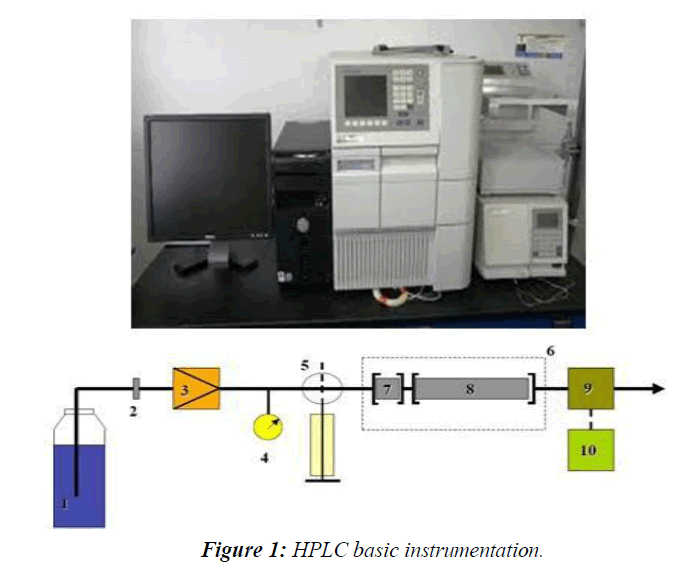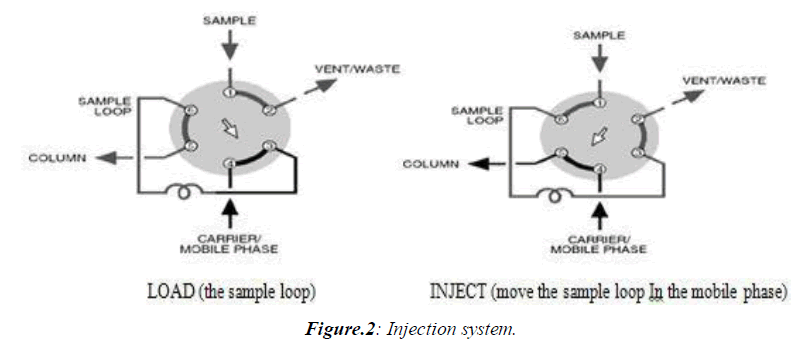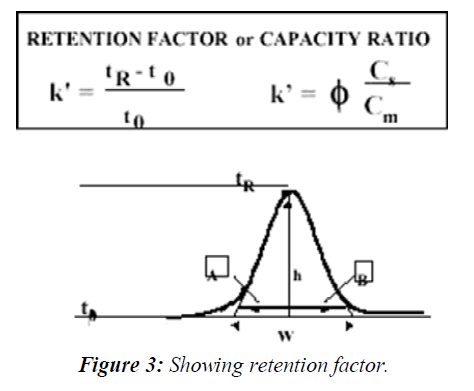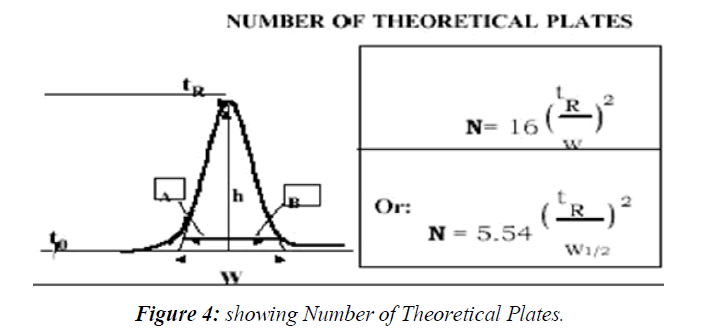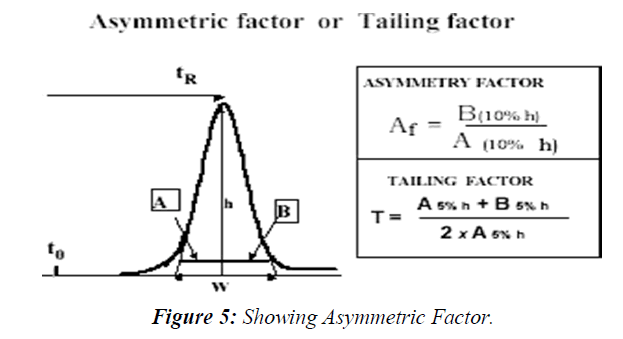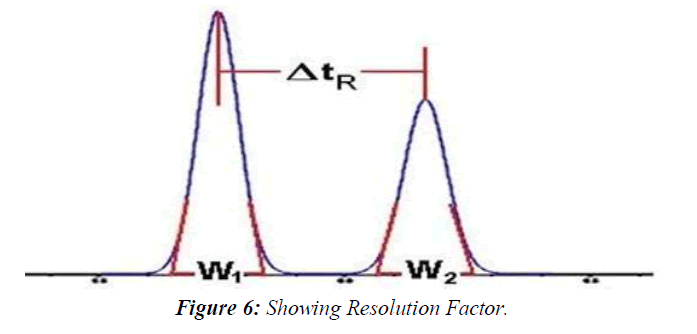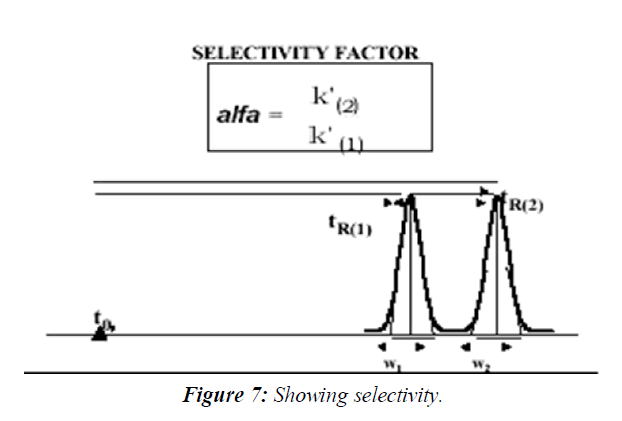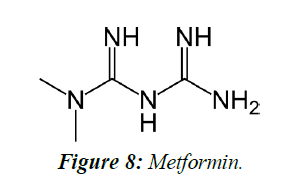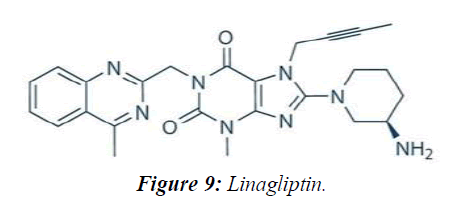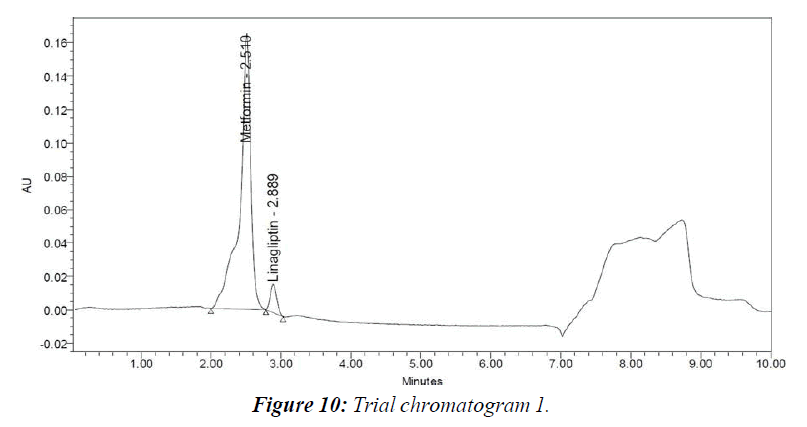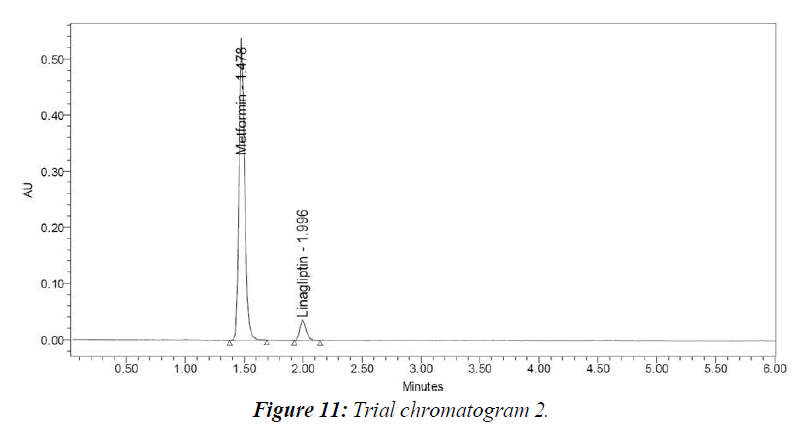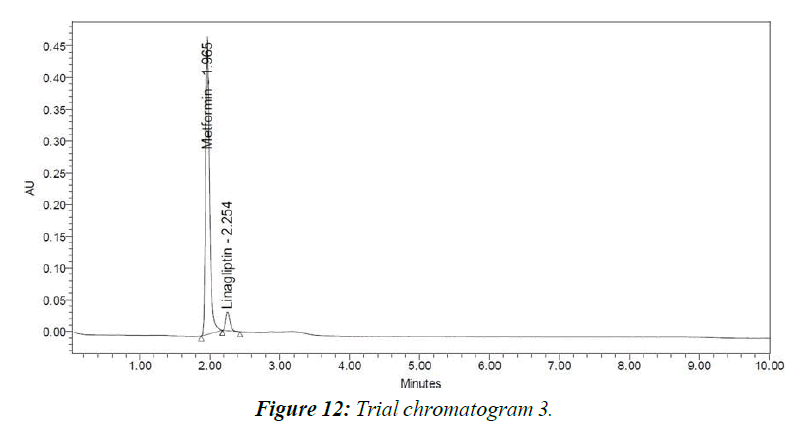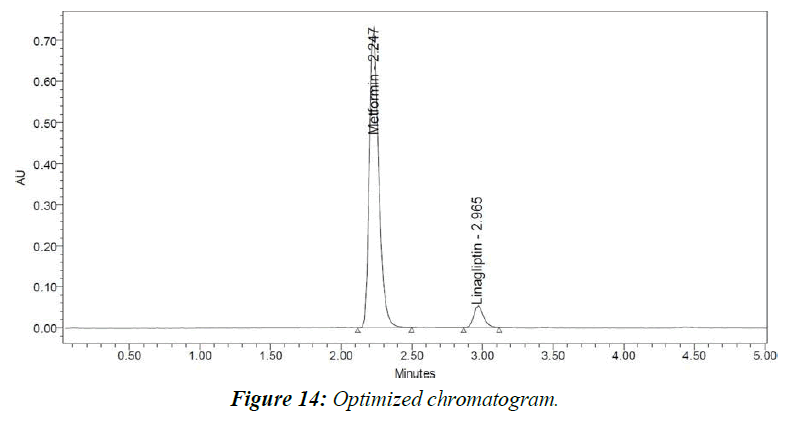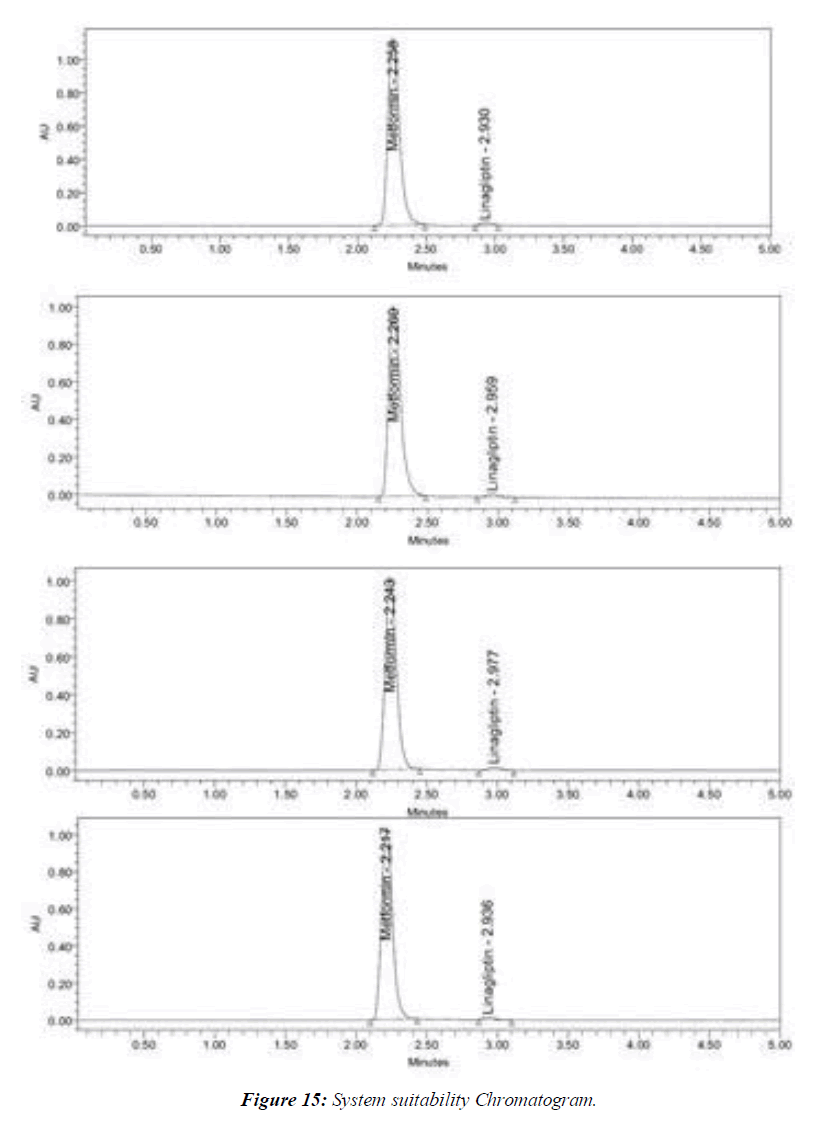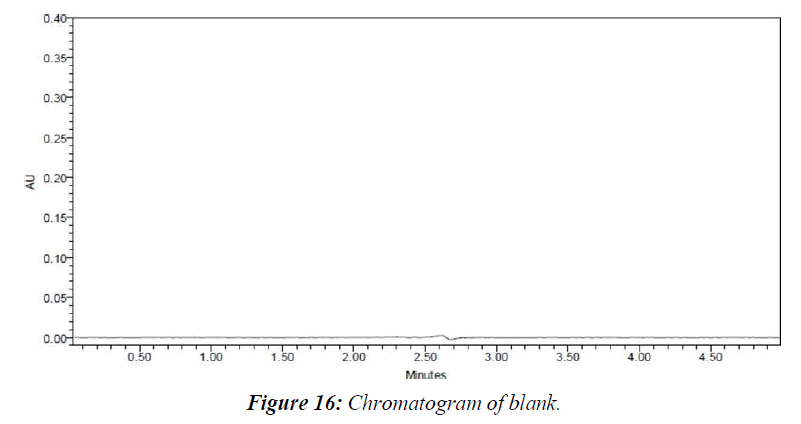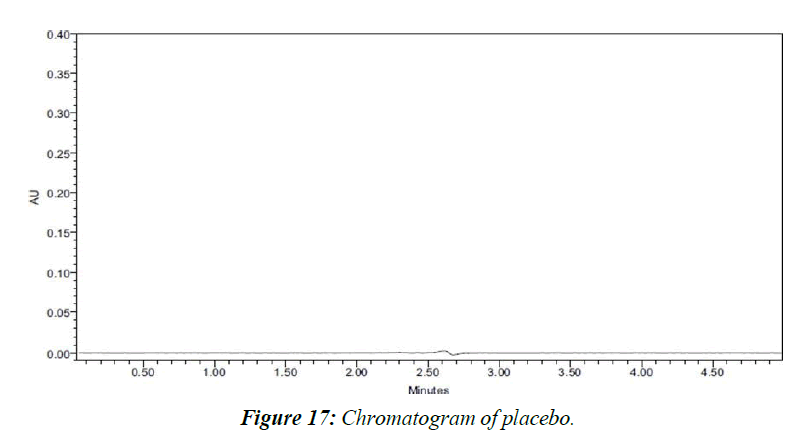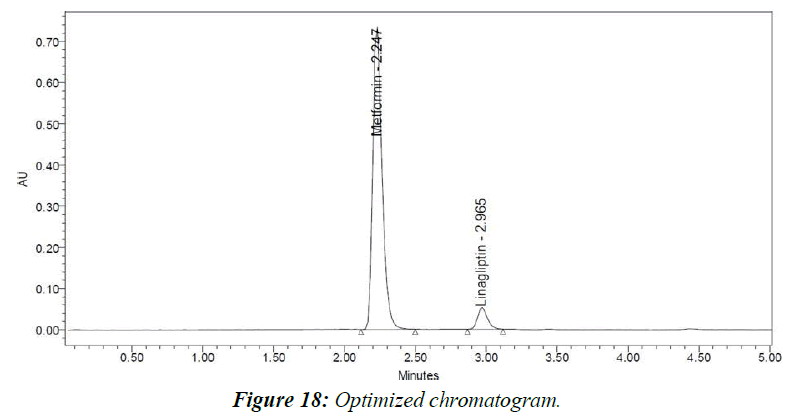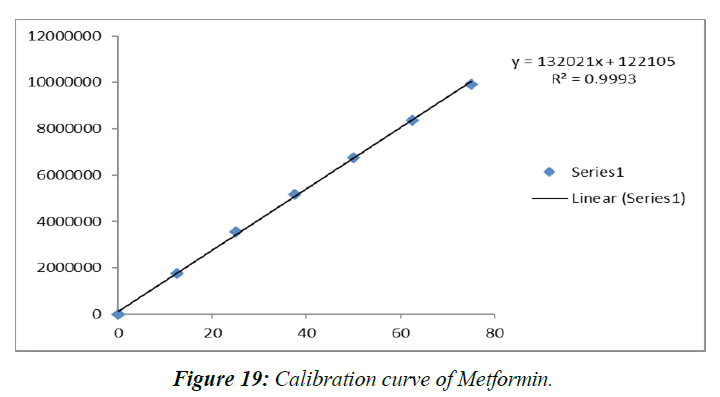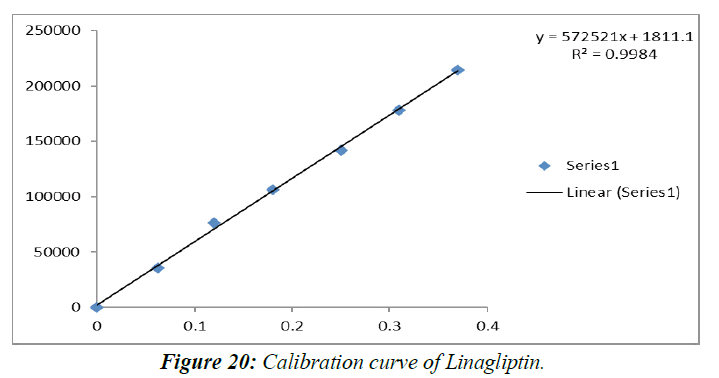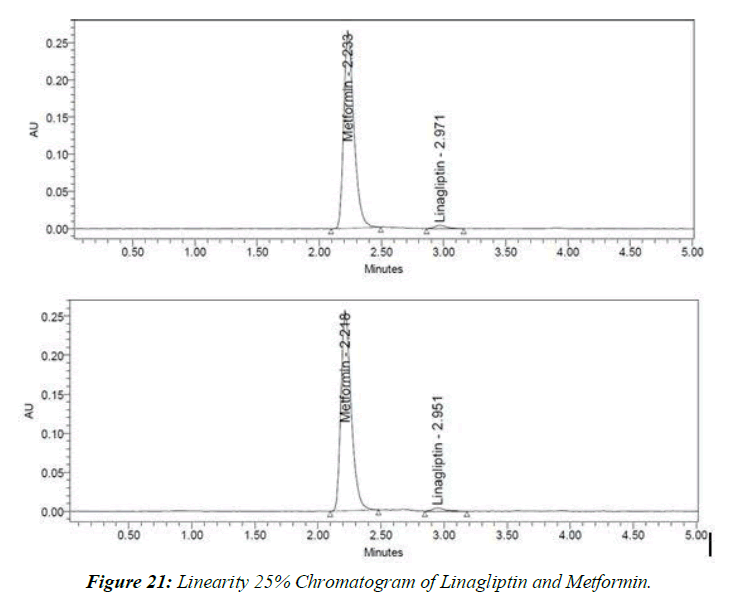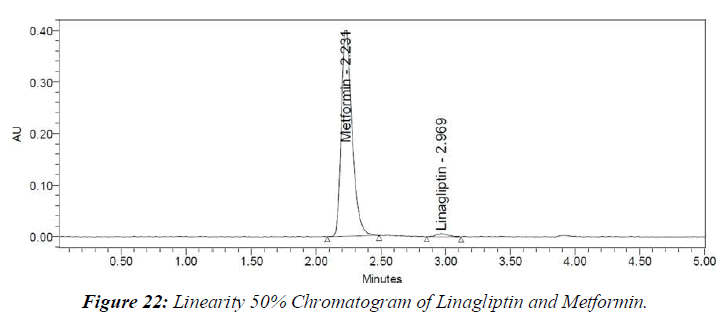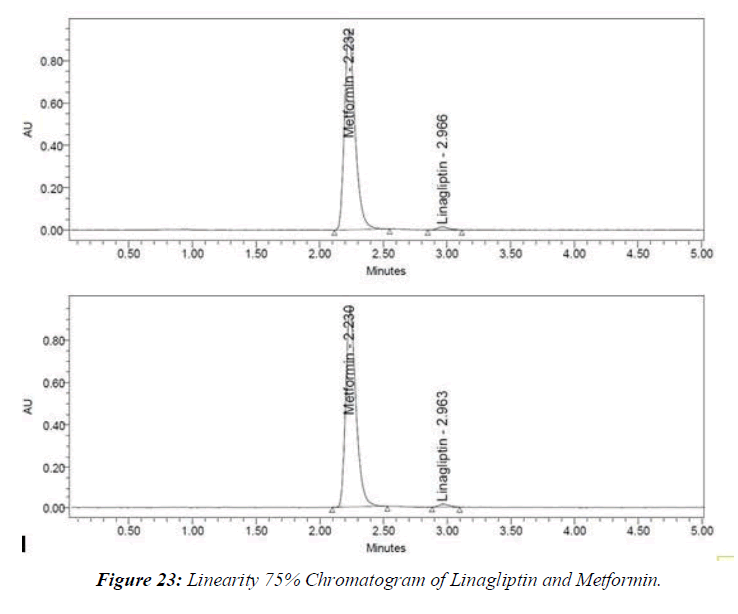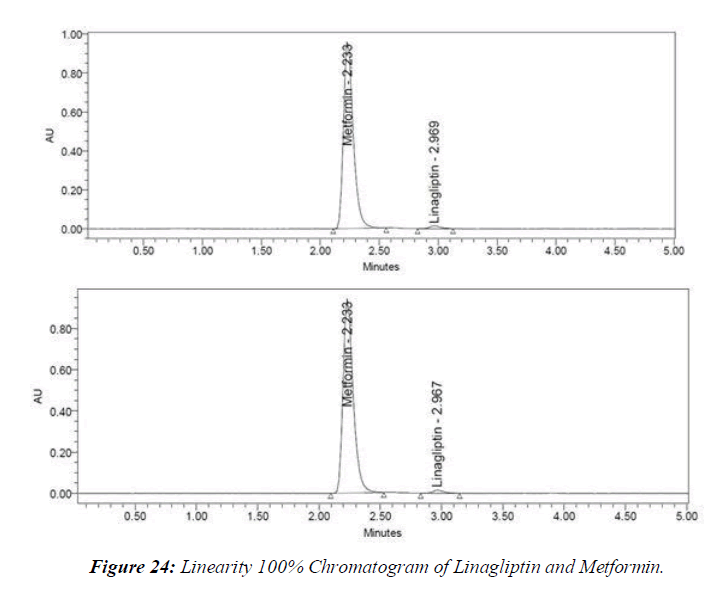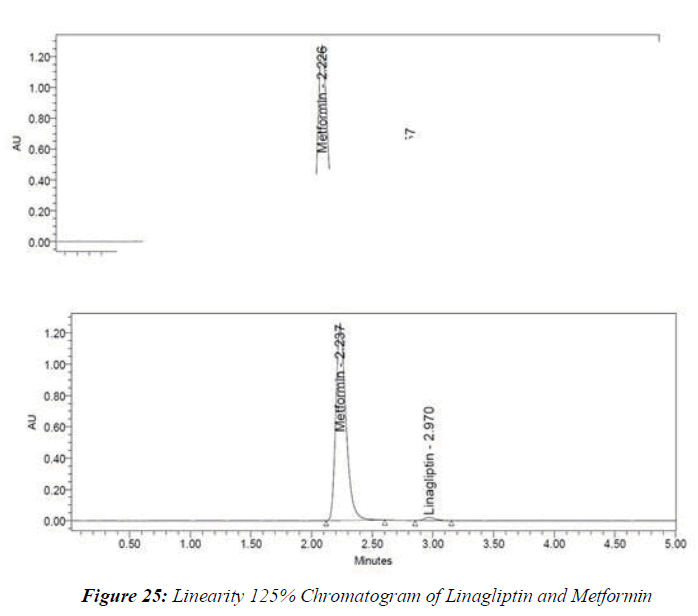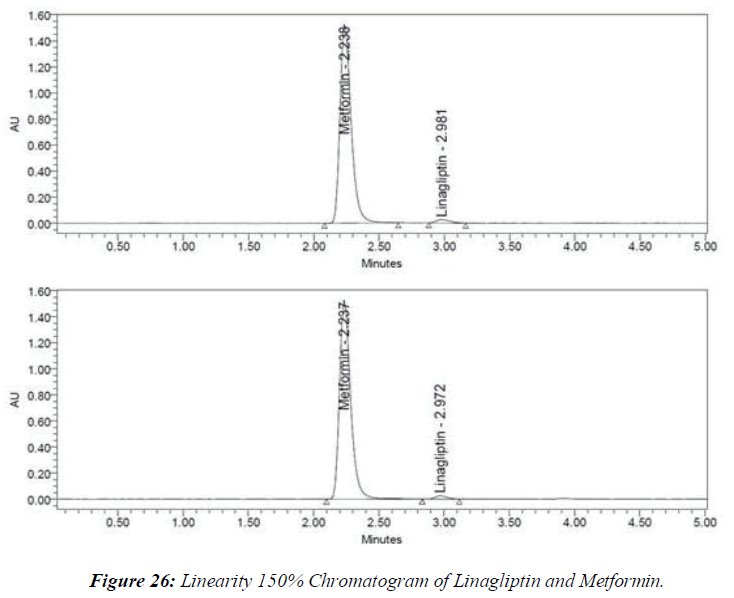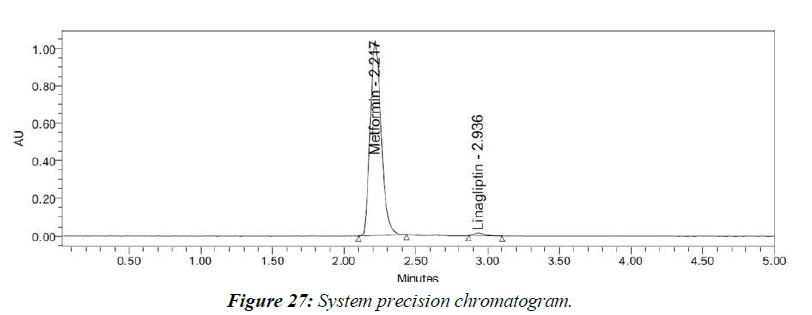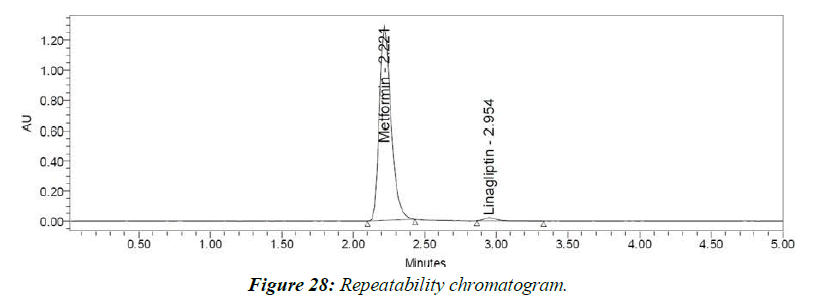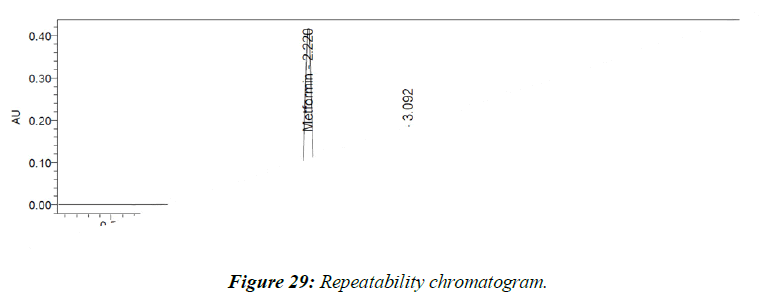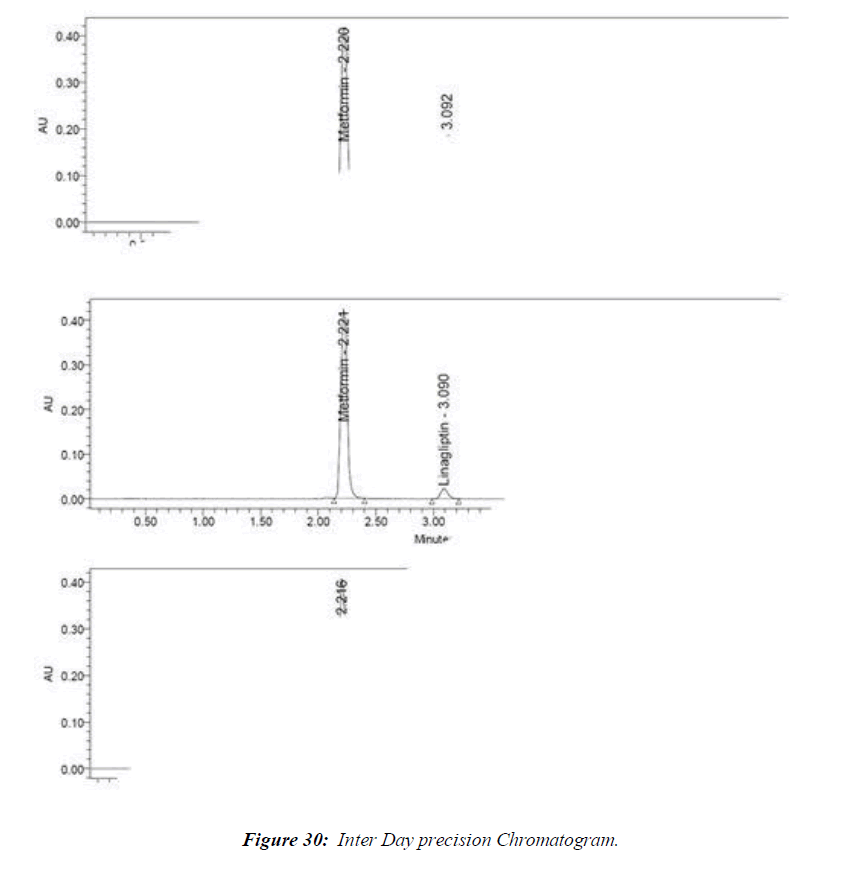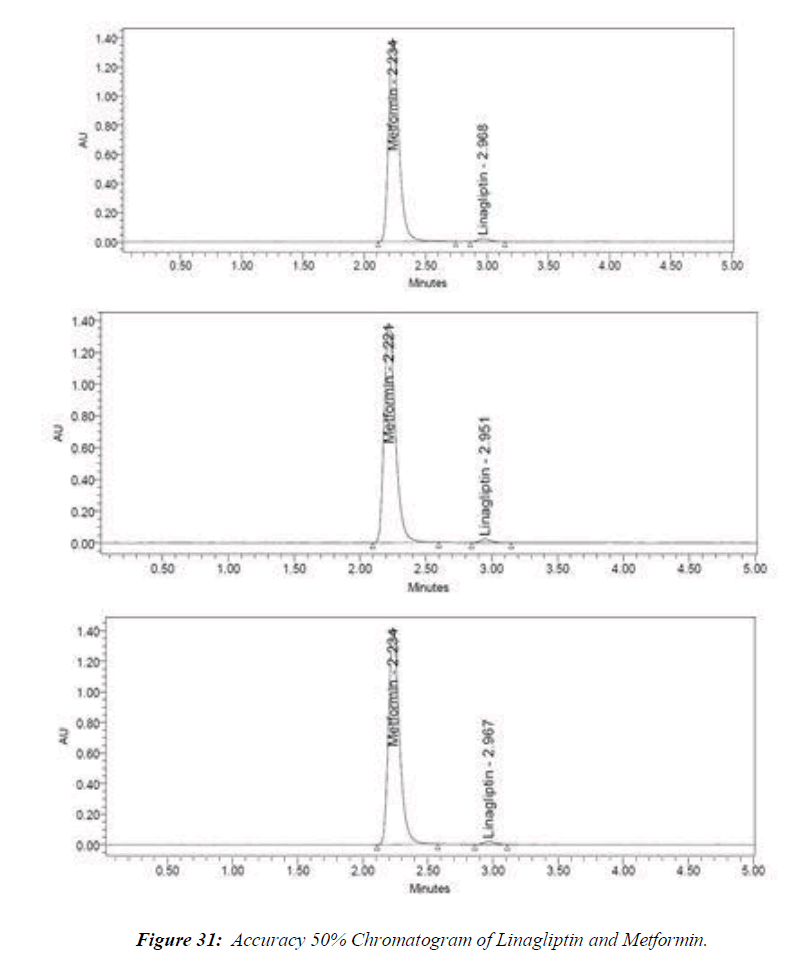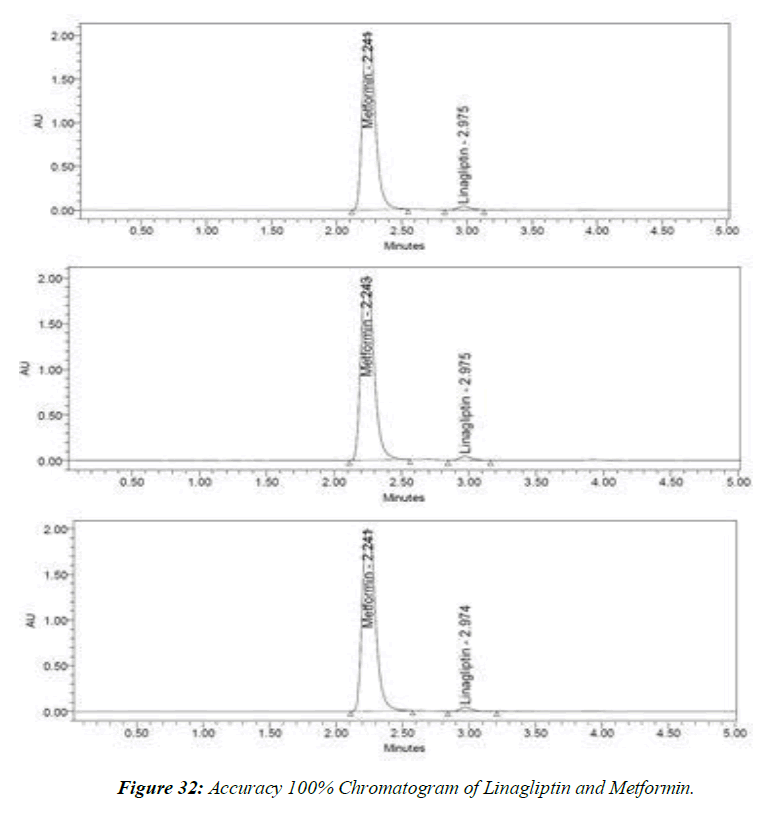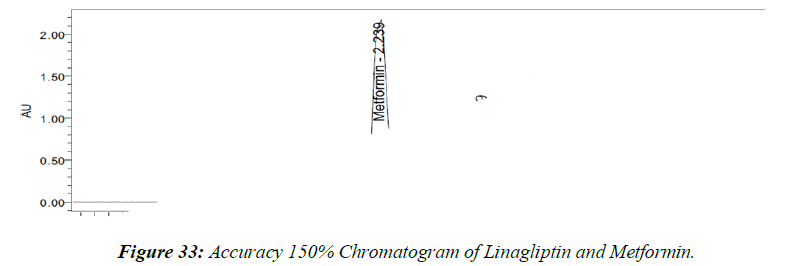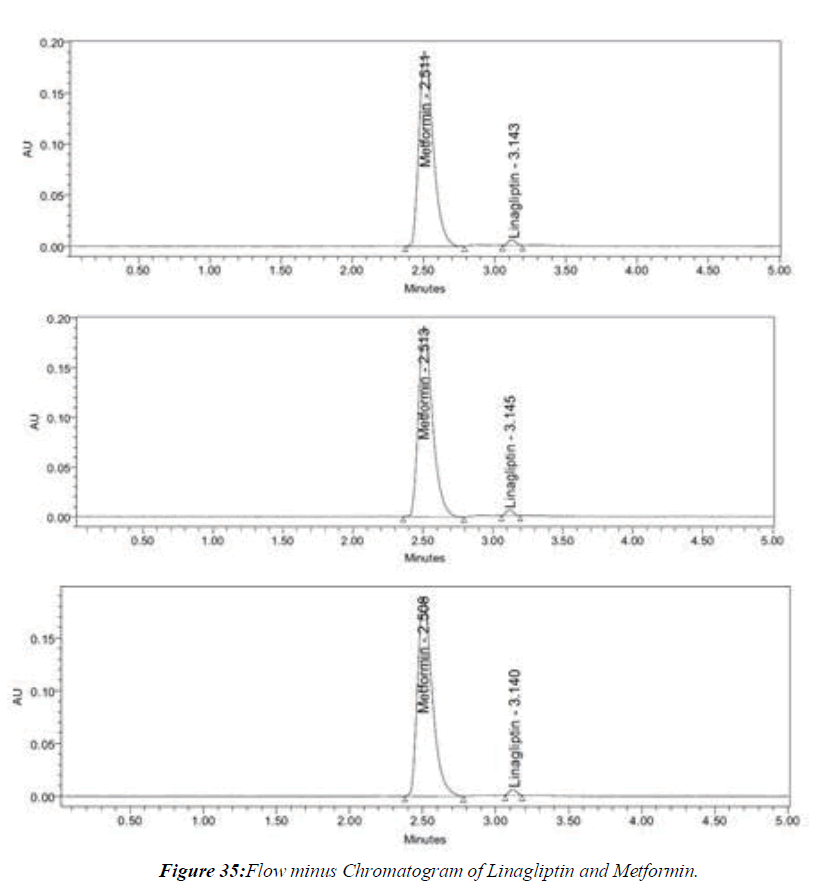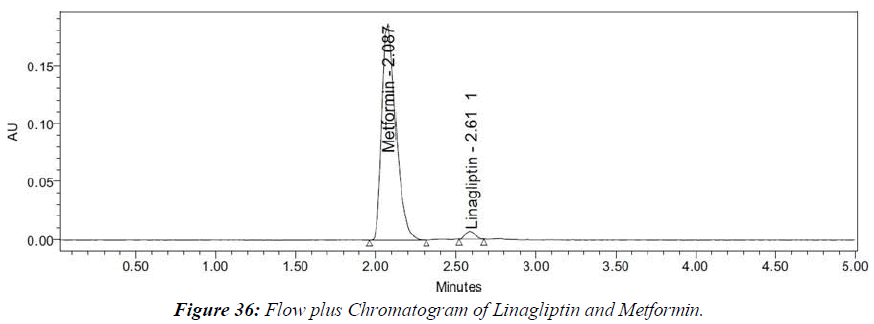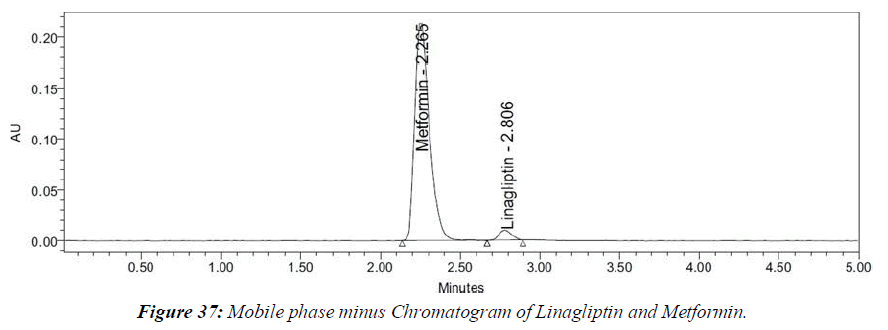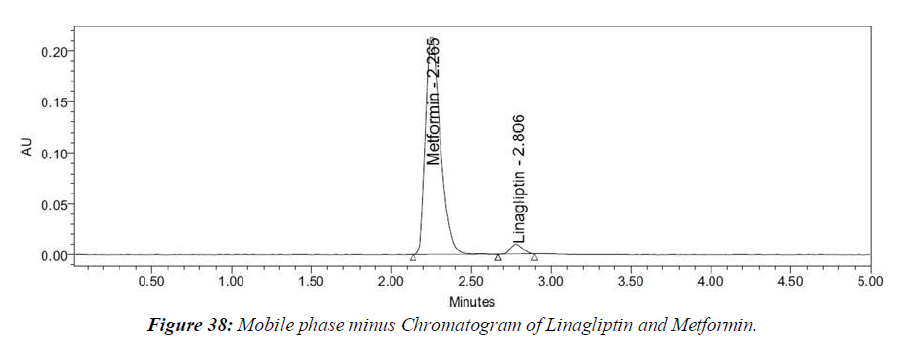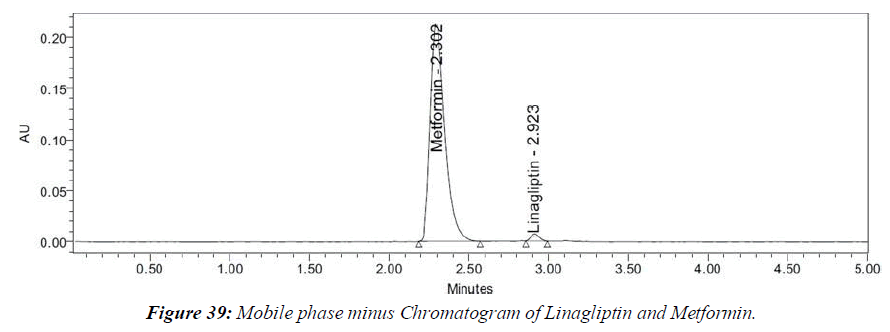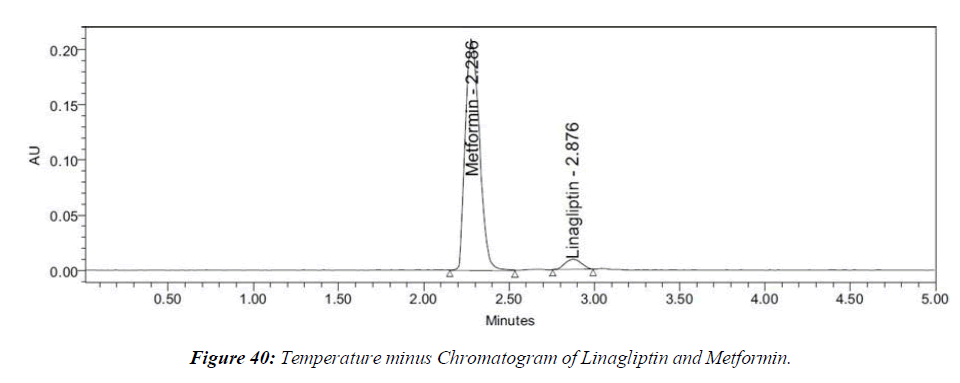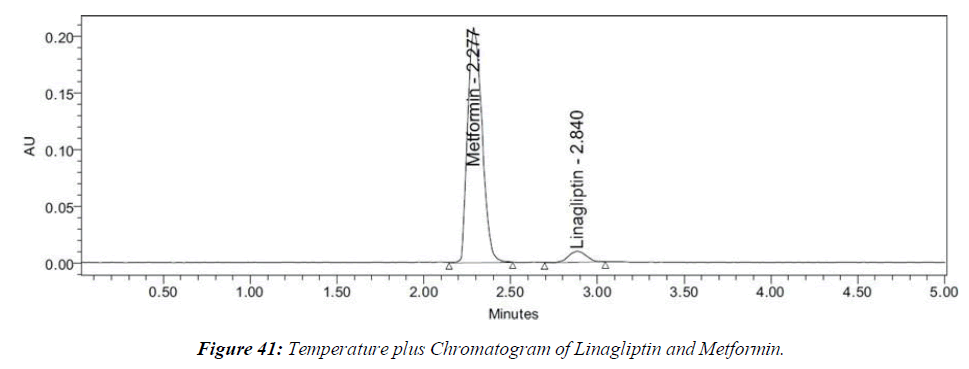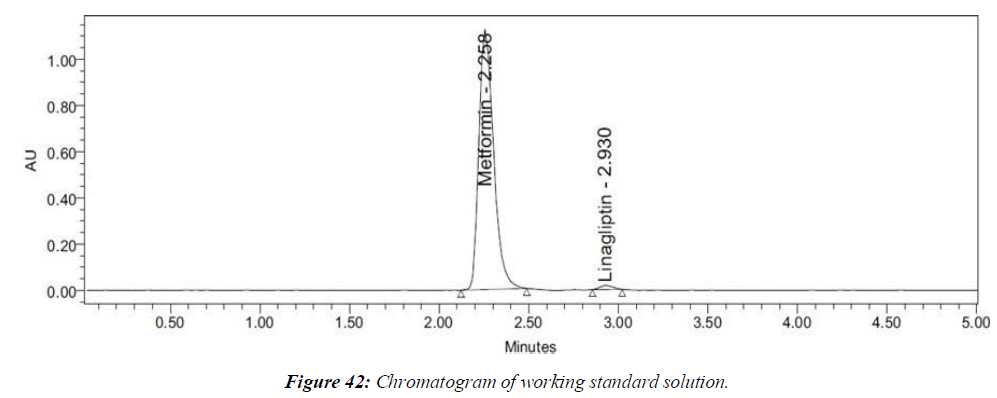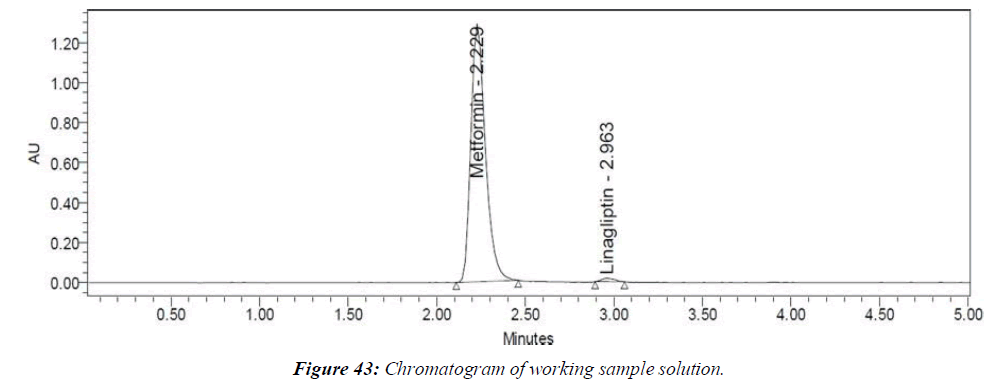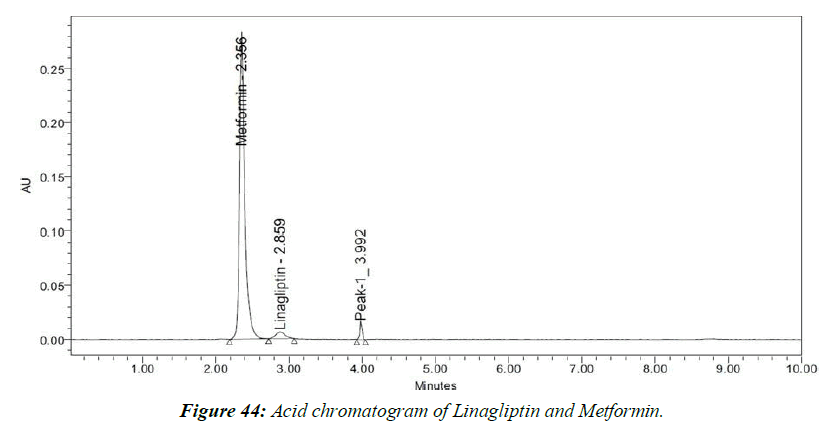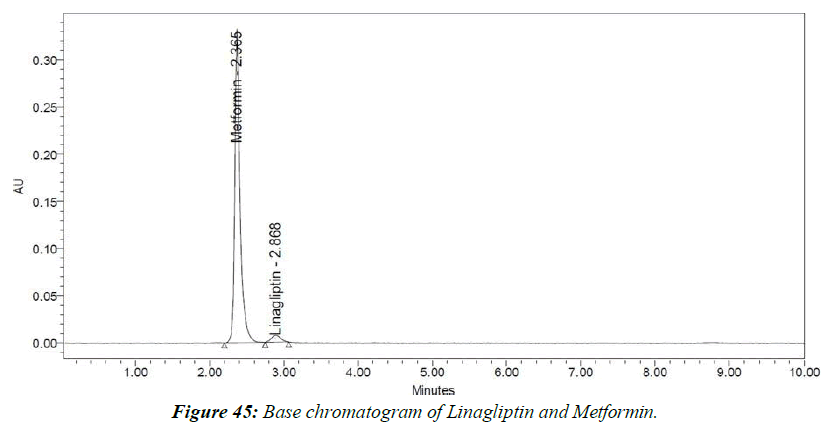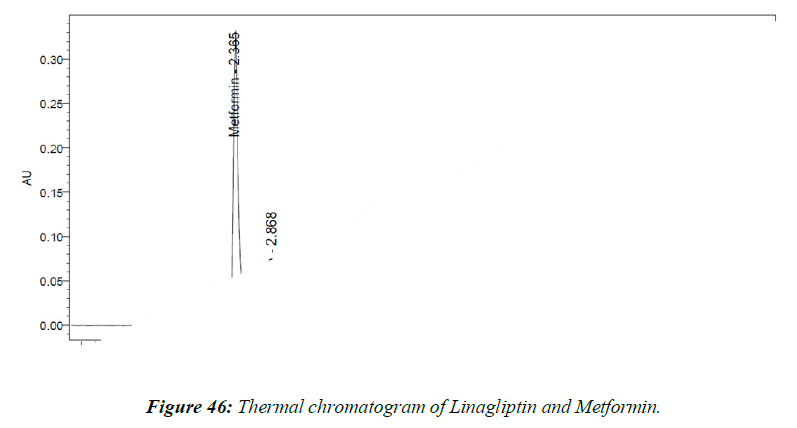Research Article - Asian Journal of Biomedical and Pharmaceutical Sciences (2024) Volume 14, Issue 103
RP-HPLC Method for simultaneous Estimation of Metformin and lingaliptin in Pharmaceutical formulation
Erri Prashanth Reddy1*, Dr. G. Nagamallika21Deaprtment of Pharmaceutical analysis, Osmania University, Hyderabad Telangana, India
2Department of Pharmaceutical Chemistry, Omega college of pharmacy, Ghatkasar, India
- *Corresponding Author:
- Erri Prashanth Reddy
Deaprtment of Pharmaceutical analysis
Osmania University
Hyderabad Telangana, India
E-mail: prashanthreddypr072@gmail.com
Received: 25-Dec-2023, Manuscript No. AABPS-23-123588; Editor assigned: 28-Dec-2023, PreQC No. AABPS-23-123588(PQ); Reviewed: 11-Jan-2024, QC No. AABPS-23-123588; Revised: 16-Jan-2024, Manuscript No. AABPS-23-123588 (R); Published: 28-Jan-2024, DOI:10.35841/aabps-14.103.214
Citation: Reddy PE. RP-HPLC Method for simultaneous Estimation of Metformin and lingaliptin in Pharmaceutical formulation. Asian J Biomed Pharm Sci. 2024;14(103):214
Abstract
A simple, Accurate, precise method was developed for the simultaneous estimation of the Linagliptin and Metformin in Tablet dosage form. Chromatogram was run through Ascentis C18 150 x 4.6 mm, 5?m. Mobile phase containing Buffer: Acetonitrile taken in the ratio 65:35 was pumped through column at a flow rate of 0.9 ml/min. Buffer used in this method was 0.1% OPA (2.2ph) buffer. Temperature was maintained at 30°C. Optimized wavelength selected was 216.0nm Retention time of Linagliptin and Metformin were found to be 2.965 min and 2.247 min. %RSD of the Linagliptin and Metformin were and found to be 0.9 and 0.7 respectively. %Recovery was obtained as 100.04% and 99.66% for Linagliptin and Metformin respectively. LOD, LOQ values obtained from regression equations of Linagliptin and Metformin were 0.03, 0.05 and 0.002, 0.005 respectively. Regression equation of Linagliptin is y = 572521x + 1811.1.and y = 132021x + 122105 of Metformin. Retention times were decreased and that run time was decreased, so the method developed was simple and economical that can be adopted in regular Quality control test in Industries.
Key words
Metformin, Linagliptin, RP-HPLC
Introduction
The quality of a drug plays an important role in ensuring the safety and efficacy of the drugs. Quality assurance and control of pharmaceutical and chemical formulations is essential for ensuring the availability of safe and effective drug formulations to consumers. Hence Analysis of pure drug substances and their pharmaceutical dosage forms occupies a pivotal role in assessing the suitability to use in patients. The quality of the analytical data depends on the quality of the methods employed in generation of the data [1] . Hence, development of rugged and robust analytical methods is very important for statutory certification of drugs and their formulations with the regulatory authorities.
The quality and safety of a drug is generally assured by monitoring and controlling the assay and impurities effectively. While assay determines the potency of the drug and impurities will determine the safety aspect of the drug. Assay of pharmaceutical products plays an important role in efficacy of the drug in patients.
The wide variety of challenges is encountered while developing the methods for different drugs depending on its nature and properties. This along with the importance of achieving the selectivity, speed, cost, simplicity, sensitivity, reproducibility and accuracy of results gives an opportunity for researchers to come out with solution to address the challenges in getting the new methods of analysis to be adopted by the pharmaceutical industry and chemical laboratories. Different physico-chemical methods are used to study the physical phenomenon that occurs as a result of chemical reactions. Among the physico-chemical methods, the most important are optical (refractometry, polarimetry, emission and fluorescence methods of analysis), photometry (photocolorimetry and spectrophotometry covering UV- Visible, IR Spectroscopy and nepheloturbidimetry) and chromatographic (column, paper, thin layer, gas liquid and high performance liquid chromatography) methods. Methods such as nuclear magnetic resonance (NMR) and para magnetic resonance (PMR) are becoming more and more popular. The combination of mass spectroscopy (MS) with gas chromatography is one of the most powerful tools available. The chemical methods include the gravimetric and volumetric procedures which are based on complex formation; acid-base, precipitation and redox reactions. Titrations in non-aqueous media and complexometry have also been used in pharmaceutical analysis. The number of new drugs is constantly growing. This requires new methods for controlling their quality. Modern pharmaceutical analysis must need the following requirements.
1. The analysis should take a minimal
2. The accuracy of the analysis should meet the demands of
3. The analysis should be
4. The selected method should be precise and
Chromatography
Chromatography (Chroma means ‘color’ and graphein means to ‘write’) is the collective term for a set of laboratory techniques for the separation of mixtures. It involves passing a mixture dissolved in a "mobile phase" through a stationary phase [2-5]. Which separates the analyte to be measured from other molecules in the mixture based on differential partitioning between the mobile and stationary phases. Differences in compounds partition coefficient results in differential retention on the stationary phase and thus changing the separation.
Different types of chromatographic techniques were summarized in (Table 1)
| Sl. No | Basic principle involved | Type of Chromatography |
|---|---|---|
| 1 | Techniques by chromatographic bed shape |
Column chromatography |
| Paper chromatography | ||
| Thin layer chromatography | ||
| 2 | Techniques by physical state of mobile phase | Gas chromatography |
| Liquid chromatography | ||
| 3 | Affinity chromatography | Supercritical fluid chromatography |
| 4 | Techniques by separation mechanism | Ion exchange chromatography |
| Size exclusion chromatography | ||
| 5 | Special techniques | Reversed phase chromatography |
| Simulatedmoving-bed chromatography | ||
| Pyrolysis gas chromatography | ||
| Fast protein liquid chromatography | ||
| Counter current chromatography | ||
| Chiral chromatography |
Table 1: Different types of chromatographic techniques
Chromatography may be preparative or analytical. The purpose of preparative chromatography is to separate the components of a mixture for further use (and is thus a form of purification). Analytical chromatography is done normally with smaller amounts of material and is for measuring the relative proportion of analytes in a mixture.
High performance liquid chromatography (HPLC)
Liquid chromatography is an analytical chromatographic technique that is useful for separating ions or molecules that are dissolved in a solvent. If the sample solution is in contact with a second solid or liquid phase to differing degrees due to differences in adsorption, ion exchange, partitioning or size. These differences will allow the mixture components to be separated from each other by using these differences to determine the time of the solutes through a column. During 1970’s, most chemical separations were carried out using a variety of techniques including open-column chromatography, paper chromatography and thin layer chromatography (TLC). However, these chromatographic techniques were inadequate for quantification of compounds and resolution between similar compounds. During this time pressure liquid chromatography began to be used to decreased flow through time, thus reducing separation time of compounds being isolated by column chromatography. However, flow rates were inconsistent, and the question of whether it was better to have constant flow rate or constant pressure debated. High pressure liquid chromatography quickly improved with the development of column packing materials. Additional convenience of on- line detectors became rapidly a powerful separation technique and is today called as High Performance Liquid Chromatography (HPLC).
Classification of HPLC
Based on modes of chromatography
• Normal phase chromatography
• Reverse phase chromatography
Based on principle of separation
• Adsorption chromatography
• Partition chromatography
• Ion exchange chromatography
• Size exclusion chromatography
• Affinity chromatography
• Chiral phase chromatography
Based on elution technique
• Isocratic separation
• Gradient separation
Based on the scale of operation
• Analytical HPLC
• Preparative HPLC
Normal phase high performance liquid chromatography (NP-HPLC)
NP-HPLC explores the differences in the strength of the polar interactions of the analytes in the mixture with the stationary phase. The stronger the analyte-stationary phase interaction, the longer the analyte retention. Analyte molecules compete with the mobile phase molecules for the adsorption sites on the surface of the stationary phase. The stronger the mobile phase interactions with the stationary phase, the lower the difference between the stationary phase interactions and the analyte interactions, and thus the lower the analyte retention. Mobile phases in NP-HPLC are based on non-polar solvents (such as hexane, heptanes, etc.) with the small addition of polar modifier (i.e., methanol, ethanol). Packing materials traditionally used in NP-HPLC are usually porous oxides such as silica (SiO2) or alumina (Al2O3). Surface of these stationary phases is covered with the dense population of OH groups, which makes these surfaces highly polar. Chemically modified stationary phases can also be used in NP-HPLC. Silica modified with trimethoxy glycidoxypropyl silanes (common name: diol-phase) is typical packing material with decreased surface polarity. Since NP-HPLC uses mainly non-polar solvents, it is the method of choice for highly hydrophobic compounds (which may show very stronger interaction with non polar mobile phases), which are insoluble in polar or aqueous solvents [6-9].
Reversed phase high performance liquid chromatography (RP-HPLC)
As opposed to NP-HPLC, RP-HPLC employs mainly dispersive forces (hydrophobic or vanderwal’s interactions). The polarities of mobile and stationary phases are reversed, such that the surface of the stationary phase in RP-HPLC is hydrophobic and mobile phase is polar , where mainly water-based solutions are employed. RP-HPLC is by far the most popular mode of chromatography. Almost 90 % of all analyses of low-molecular-weight samples are carried out using RP-HPLC. Dispersive forces employed in this separation mode are the weakest intermolecular forces, thereby making the overall background interaction energy in the chromatographic system very low compared to other separation techniques. This low background energy allows for distinguishing very small differences in molecular interactions of closely related analytes. Adsorbents employed in this mode of chromatography are porous rigid materials with hydrophobic surfaces. The majority of packing materials used in RP-HPLC are chemically modified porous silica.
Adsorption chromatography
The analyte interact with solid stationary surface and are displaced with eluent for active sites on surface.
Partition chromatography
This method results from a thermodynamic distribution of analytes between two liquid phases. On the basis of relative polarities of stationary and mobile phase, partition chromatography can be divided in to normal phase and reverse phase chromatography. In normal phase chromatography, the stationary phase bed is strongly polar in nature (e.g. silica gel) and the mobile phase is non polar (such as n-hexane or tetrahydrofuran). Polar sample are thus retained on polar surface of the column packing longer than polar material while in reverse phase chromatography, the stationary bed is non polar (hydrophobic in nature, while the mobile phase is polar liquid, such as mixture of water and methanol or acetonitrile).
Size exclusion chromatography
This involves a solid stationary phase with controlled pole size. Solids are separated according to molecular size, with the large molecule unable to enter the pores eluted first.
Ion exchange chromatography (IEC)
IEC is based on the differences in affinities of the analyte ions for the oppositely charged ionic center in the resin or adsorbed counter ions in the hydrophobic stationary phase. Consider the exchange of two ions A+ and B+ between the solution and exchange resin
E−: A•E + B+ ↔B•E + A+
The equilibrium constant for this process is shown in Eq. below
K = ([A+][BE])/([AE][B+])
This essentially determines the relative affinity of both cations to the exchange centres on the surface. If the constant is equal to 1, no discriminating ability is expected for this system. The higher the equilibrium constant (provided that, it is greater than 1), the greater the ability of action B+ to substitute A on the resin surface. Depending on the charge of the exchange centres on the surface, the resin could be either anion-exchanger (positive ionic centers on the surface) or cation-exchanger (negative centres on the surface). Cross linked styrene-divinyl benzene is the typical base material for ion exchange resin. Exchange groups are attached to the Phenyl rings in the structure and the degree of cross linkage is between 5 % and 20 %. The higher the cross linkage, the harder the material and the less susceptible it is to swelling, but the material usually shows lower ion-exchange capacity. Four major types of ion- exchange centres are usually employed:
• SO3-—strong cation-exchanger
• CO2-—weak cation-exchanger
• Quaternary amine—strong anion-exchanger
• Tertiary amine—weak anion-exchanger
Analyte retention and selectivity in ion exchange chromatography are strongly dependent on the pH and ionic strength of the mobile phase.
Size exclusion chromatography (SEC)
SEC is the method for dynamic separation of molecules according to their size. The separation is based on the exclusion of the molecules from the porous space of packing material due to their steric hindrance. Hydrodynamic radius of the analyte molecule is the main factor determining its retention. This is the only chromatographic separation method where any positive interaction of the analyte with the stationary phase should be avoided.
In SEC, the higher the molecular weight of the molecule, the greater its hydrodynamic radius results in faster elution. At the same time, if an analyte molecule interacts (undesired) with the stationary phase, thus increasing the retention of larger molecules, which may conform separation of molecules based solely on their hydrodynamic radius. The adsorbent pore size distribution plays the dominant role in the adsorbent ability to discriminate molecules according to their molecular weight. Hydrodynamic radius of the polymer is also dependent on the analyte interaction with the solvent. Polymer conformation and degree of the salvation varies with the variation of the solvent properties.
Instrumentation of hplc
HPLC is a special branch of Column Chromatography in which the mobile phase is forced through the column at high speed. As a result, the analysis time is reduced by 1-2 orders of magnitude relative to classical Column Chromatography and the use of much smaller particles of the absorbent or support becomes possible increasing the column efficiency substantially. The Basic HPLC Instrumentation was shown in the (Figure 1)
Solvent delivery system
The most important component of HPLC in solvent delivery system is the pump, because its performance directly effects the retention time, reproducibility and detector sensitivity. Among the several solvent delivery systems, (direct gas pressure, pneumatic intensifier, reciprocating etc.) reciprocating pump with twin or triple pistons is widely used, as this system gives less baseline noise, good flow rate reproducibility etc.
The pumping systems used in HPLC can be categorized in three different ways.
➢ The first classification is according to the eluent flow rate that the pump is capable of delivering.
➢ The second classification is according to the construction materials.
➢ The final classification is according to the mechanism by which the pump delivers the eluent.
Each of these classifications is considered below.
Pump classification according to flow rate
When classified in terms of flow rate, pumps may be defined as micro bore or preparative.
➢ Standard bore systems are the most commonly used pumping systems for analytical HPLC because they provide reliable operation at flow rates ranging from 100 µl / min to 10 µl / min.
➢ Micro bore systems are intended for use with column diameters ranging up to 2 mm. The narrow column diameter and small size of the packing material causes relatively low flow rates for the pumping system, from 1 to 250 µl / min as the minimum head size for reciprocating pumps is around 25 µl, smooth, reliable operation at flow rates less than 10 µl / min is difficult.
Pump classification according to materials of construction
Pumps may also be classified according to the primary construction materials. The pumps are classified as
➢ Metallic
➢ Non-metallic, depending on the material used for the eluent flow path.
➢ The most commonly used material for HPLC pumping systems is 316 stainless steel, because of its mechanical strength, corrosion resistance, good thermal stability and malleability. Only a handful of HPLC solvents such as Hydrochloric acid will cause damage to 316 stainless steel. Therefore pumps are also constructed from non-metallic materials such as PEEK (poly ethyl ethyl ketone), Teflon (poly tetra fluoro ethylene) and Ceramics.
Pump classification according to mechanism of eluent displacement
The third classification of pumps is according to the mechanism by which the liquid is forced through the chromatograph. The pumps are classified into two types. They are
➢ syringe pumps and
➢ reciprocating-piston pump
HPLC systems are also provided an online degassing system which continuously removes the dissolved gases from the mobile phase.
Solvent degassing system
The constituents of the mobile phase should be degassed and filtered before use. Several methods can be applied to remove the dissolved gases in the mobile phase. They include
➢ heating and stirring,
➢ vacuum degassing with an aspirator,
➢ filtration through 0.45μm filters,
➢ vacuum degassing with an air-soluble membrane,
➢ Helium purging ultra signification or purging or combination of these methods.
Sample introduction system
Two means for analyte introduction on the column are injection into a flowing stream and a stop flow injection. These techniques can be used with a syringe or an injection valve. Automatic injector is a microprocessor-controlled version of the manual universal injector.
Injector
Injectors should provide the possibility of injecting the liquid sample within the range of 0.1 to 100 ml of volume with high reproducibility and under high pressure (up to the 4000 psi). They should also produce minimum band broadening and minimize possible flow disturbances. The most useful and widely used sampling device for modern LC is the micro sampling injector valve. With these sampling valves, samples can be introduced reproducibly into pressurized columns without significant interruption of flow even at elevated temperatures. (Figure 2)
Columns
The heart of the system is the column. Analytical column is the most important part of the HPLC which decides the efficiency of separation. The choice of common packing material and mobile phases depends on the physical properties of the drug.
The following properties of the column stationary phases play an important role in giving different selectivity for separations.
1. Particle size
2. Particle shape
3. Pore size / Pore volume
4. Specific surface area,
5. End capping vi) % carbon loading
The following are the most widely used columns with stationary phases for separation and quantification of wide variety of drugs.
1. Pure silica and hybrid silica columns.
2. Silica based columns with different bonding phases like C4, C6, C8, C18, C20 and bonding phases having functional groups like cyano, phenyl, naphthyl and amino.
3. Silica based columns with polar embedded phases within chains of C8, C18, NH2.
4. Hybrid silica based columns like C4, C6, C8, C18, C20 and bonding phases having functional groups like cyano, phenyl, naphthyl and Amino.
5. Strong cation exchange (SCX) and strong anion exchange (SAX) columns.
6. Size Exclusion chromtography (SEC) or gel permeation chromatography (GPC) columns.
7. Silica based monolith columns.
8. Fused core silica columns with bonding phases like C8, C18, CN, phenyl.
9. Metal oxide columns like zirconia based and alumina based.
10. Chiral columns.
Column-packing materials
Silica (SiO2.X H2O) is the most widely used substance for the manufacture of packing materials it consist of a network of siloxane linkages(Si-O-Si) in a rigid three dimensional structure containing inter connected pores. Thus a wide range of commercial products are available with surface areas ranging from 100 to 800 m2/g and particle sizes from 3 to 50 µm. The silonol groups on the surface of silica give it a polar character, which is exploited in adsorption chromatography using non-polar organic elutents. Silica can be drastically altered by reaction with organochlorosilanes or organoalkoxysilanes giving Si-O-Si-R linkages with the surface. The attachment of hydrocarbon chain to silica produces a non polar surface suitable for reversed phase chromatography where mixtures of water and organic solvents are used as eluents. The most popular material is octa decyl silica (ODS) which contains C18chains, but material with C2, C6, C8 and C22 chains are also available. During manufacture, such materials can be reacted with a small mono functional silane (eg: trimethychlorosilane) to reduce further number of silanol groups remaining on the surface (end capping). There is a vast range of materials which have intermediate surface polarities arising from the bonding to silica of other organic compounds which contain groups such as phenyl, nitro, amino and hydroxyl. Strong ion exchange is also available in which sulphonic acid groups and quaternary ammonium groups are bonded to Silica. The useful pH range for columns is 2 to 8, since Siloxane linkages are cleaved below pH 2 while at pH values above 8 Silica may dissolve. In HPLC, generally two types of columns are used, normal phase column and reversed phase column. Using normal phase chromatography, particularly of non-polar and moderately polar drugs can make excellent separation and was originally believed that separation of compounds in mixtures takes place slowly by differential adsorption on a stationary silica phase. However, it now seems that partition plays an important role, with the compounds interacting with the polar silonol groups on the silica or with bound water molecules. While in normal phase, seems the passage of a relatively non-polar mobile phase over a polar stationary phase, reversed phase chromatography is carried out using a polar mobile phase such as methanol, acetonitrile, water, buffer etc. over a non polar stationary phase. A range of stationary phases (C18, C8, -NH2, -CN, -Phenyl etc.) are available and very selective separation can be achieved.
The most popular brands of LC columns are Inertsil, Hypersil, X-terra, X-bridge, Sun- fire, Atlantis, Aquity-BEH, Zorbax, Lichrosphere, Purosphere, Sperisorb, Luna, Kromasil, ACE, YMC, Symmetry, Chiralcel and Chiralpak. These LC columns are supplied in different dimensions, viz., lengths of 10 mm, 50 mm, 100mm, 150mm, 250mm, 300mm, 500mm and internal diameters of 2.1mm, 3.0mm, 4.0mm, 4.6mm. LC columns with stationary phases having different particle sizes like 5.0 µm, 4.0 µm 3.5 µm, 3.0 µm, 2.5 µm, 2.0 µm, 1.9 µm, 1.8 µm, 1.7 µm and 1.3 µm are available.
Mobile phase
Mobile phases used for HPLC are typically mixtures of organic solvents and water or aqueous buffers.
The following points should also be considered when choosing a mobile phase:
➢ It is essential to establish that the drug is stable in the mobile phase for at least the duration of the analysis.
➢ Excessive salt concentrations should be avoided. High salt concentrations can result in precipitation which can damage HPLC equipment. Reduce cost and toxicity of the mobile phase by using methanol instead of acetonitrile whenever possible.
➢ Minimize the absorbance of buffer. Since trifluroacetic acid or formic acid absorb at shorter wavelengths. They may prevent detection of products without chromophores above 220 nm. Carboxylic acid modifiers can be frequently replaced by phosphoric acid which does not absorb above 200 nm. (Table 2)
| 7 | MW | BP | RI (25°C) | UV Cut-off (nm) | Density g / ml (25°C) | Viscosity cP (25°C) | Dielectric |
|---|---|---|---|---|---|---|---|
| Acetonitrile | 41 | 82 | 1.342 | 190 | 0.787 | 0.358 | 38.8 |
| Dioxane | 88.1 | 101 | 1.42 | 215 | 1.034 | 1.26 | 2.21 |
| Ethanol | 46.1 | 78 | 1.359 | 205 | 0.789 | 1.19 | 24.5 |
| Ethyl acetate | 88.1 | 77 | 1.372 | 256 | 0.901 | 0.45 | 6.02 |
| Methanol | 32 | 65 | 1.326 | 205 | 0.792 | 0.584 | 32.7 |
| CH2Cl2 | 84.9 | 40 | 1.424 | 233 | 1.326 | 0.44 | 8.93 |
| Isopropanol | 60.1 | 82 | 1.375 | 205 | 0.785 | 2.39 | 19.9 |
| n-propanol | 60.1 | 97 | 1.383 | 205 | 0.804 | 2.2 | 20.3 |
| THF | 72.1 | 66 | 1.404 | 210 | 0.889 | 0.51 | 7.58 |
| Water | 18 | 100 | 1.333 | 170 | 0.998 | 1 | 78.5 |
Table 2: Physical properties of common HPLC solvents
Detectors
When a chromophore is present, the wavelength of detection for a drug should be based on its UV Spectrum in the mobile phase and not in pure solvents. The most selective wavelength for detecting a drug is frequently the longest wavelength maximum to avoid interference from solvents, buffers and excipients. Other methods of detection can be useful are required in some instances. The detection of UV light absorbance offers both convenience and sensitivity for molecules.
• Solute specific detectors (UV-Vis, fluorescence, electrochemical, infra-red, radio activity)
• Bulk property detectors (refractive index, viscometer, conductivity)
• Desolvation detectors (flame ionization etc.)
• LC-MS detectors
• Detectors
Applications of HPLC in pharmaceutical research
1. Separation: This can be accomplished using HPLC by utilizing the fact that, certain compounds have different migration rates given a particular column and mobile phase. The extent or degree of separation is determined by the choice of stationary phase and mobile phase along with parameters like flow, temperature and gradient programme.
2. Identification: For this purpose a clean peak of known sample has to be observed from the chromatogram. Selection of column mobile phase and flow rate matter to certain level in this process. Identification is generally by comparing with reference compound based on retention time and also based on UV-Vis spectra in some cases. Identification can be assured by combining two or more detection methods, where necessary.
3. Quantification: Analyte concentrations are estimated by measuring the responses ( peak areas) known reference standards followed by unknown samples. Quantification of known and unknown components are done by various methods like area normalization method, internal standard method, external standard method and diluted standard method along with relative response factors.
4. Isolation: It refers to the process of isolation and purification of compounds using analytical scale or preparative scale HPLC. Volatile buffers and solvents are preferred choice as mobile phases as it reduces the effort on purification. Solute purity and throughput is the key challenge in isolation and purification processes [10-14].
HPLC theory
System suitability parameters
High performance liquid chromatography is defined as a separation of mixtures of compounds due to differences in their distribution equilibrium between two phases, the stationary phase packed inside columns and the mobile phase, delivered through the columns by high pressure pumps. Components whose distribution into the stationary phase is higher, are retained longer, and get separated from those with lower distribution into the stationary phase. The theoretical and practical foundations of this method were laid down at the end of 1960s and at the beginning of 1970s. The theory of chromatography has been used as the basis for system- suitability tests, which are set of quantitative criteria that test the suitability of the chromatographic system to identify and quantify drug related samples by HPLC at any step of the pharmaceutical analysis.
Retention time (tR), capacity factor k' and relative retention time (RRT)
The time elapsed between the injection of the sample components into the column and their detection is known as the retention time (tR). The retention time is longer when the solute has higher affinity to the stationary phase due to its chemical nature. For example, in reverse phase chromatography, the more lyophilised compounds are retained longer.
Therefore, the retention time is a property of the analyte that can be used for its identification. A non-retained substance passes through the column at a time t0, called the void time.
Retention factor is calculated as follows (Figure 3)
The capacity factor describes the thermodynamic basis of the separation and its definition is the ratio of the amounts of the solute at the stationary and mobile phases within the analyte band inside the chromatographic column: Where Cs is the concentration of the solute at the stationary phase and Cm is its concentration at the mobile phase and phi is the ratio of the stationary and mobile phase volumes all within the chromatographic band. The Retention Factor is used to compare the retention of a solute between two chromatographic systems, normalizing it to the column's geometry and system flow rate. The retention factor value should be in between 1-20. The need to determine the void time can be tricky sometimes, due to the instability of the elution time of the void time marker, t0, therefore, when the chromatogram is complex in nature, and one known component is always present at a certain retention time, it can be used as a retention marker for other peaks. In such cases the ratio between the retention time of any peak in the chromatogram and the retention time of the marker is used (tR (Peak) / tR (Marker)) and referred to as the Relative Retention Time (RRT). RRT is also used instead of the capacity ratio for the identification of the analyte as well as to compare its extent of retention in two different chromatographic systems. The sharpness of a peak relative to its retention time is a measure of the system's efficiency, calculated as N, plate count. Band-broadening phenomena in the column such as eddy diffusion, molecular diffusion, and mass-transfer kinetics and extra-column effects reduce the efficiency of the separation. The sharpness of a peak is relevant to the limit of detection and limit of quantification of the chromatographic system. The sharper the peak for a specific area, the better is its signal-to-noise; hence the system is capable of detecting lower concentrations. Therefore, the efficiency of the chromatographic system must be established by the system suitability test before the analysis of low concentrations that requires high sensitivity of the system, such as the analysis of drug impurities and degradation products.
Efficiency
Plate count N and peak capacity Pc
The efficiency of the separation is determined by the plate count N when working at area, the better is its signal-to-noise; hence the system is capable of detecting lower concentrations. Therefore, the efficiency of the chromatographic system must be established by the system suitability test before the analysis of low concentrations that requires high sensitivity of the (Figure 4)
isocratic conditions, whereas it is usually measured by Peak Capacity Pc when working at gradient conditions. The following equation for the plate count is used by the United States
Pharmacopoeia (USP) to calculate N
Where w is measured from the baseline peak width calculated using lines tangent to the peak width at 50 % height. European and Japanese pharmacopoeias use the peak width at 50% of the peak height, hence the equation becomes.
Peak capacity Pc is defined as number of peaks that can be separated within a retention window for a specific pre-determined resolution. In other words, it is the runtime measured in peak width units (34). It is assumed that peaks occur over the gradient chromatogram. Therefore, peak capacity can be calculated from the peak widths in the chromatogram as follows:

Where n is the number of peaks at the segment of the gradient selected for the calculation, tg. Thus peak capacity can be simply the gradient run time divided by the average peak width. The sharper the peaks the higher is the peak capacity, hence the system should be able to resolve more peaks at the selected run time as well as detect lower concentrations.
Another measure of the column's chromatographic efficiency is the height equivalent to theoretical plate (HETP) which is calculated from the following equation:
HETP = (L/N)
Where L is column length and N is the plate count. HETP is measured in micrometer.
The behaviour of HETP as function of linear velocity has been described by various equations. It is frequently called "The Van-Deemter curve", and it is frequently used to describe and characterize various chromatographic stationary phases' performance and compare them to each other. The lower are the values of HETP, the more efficient is the chromatographic system, enabling the detection of lower concentrations due to the enhanced signal-to-noise ratio of all the peaks in the chromatogram.
Peak asymmetry factor Af and tailing factor T
The chromatographic peak is assumed to have a Gaussian shape under ideal conditions, describing normal distribution of the velocity of the molecules populating the peak zone migrating through the stationary phase inside the column. Any deviation from the normal distribution indicates non-ideality of the distribution and the migration process therefore might jeopardize the integrity of the peak's integration, reducing the accuracy of the quantitation. This is the reason why USP Tailing is a peak's parameter almost always measured in the system suitability step of the analysis.
The deviation from symmetry is measured by the asymmetry factor, Af or tailing factor T. The calculation of asymmetry factor, Af is described by the following equation (Figure 5)
Where A and B are sections in the horizontal line parallel to the baseline, drawn at 10% of the peak height. The calculation of tailing Factor, T, which is more widely used in the pharmaceutical industry, as suggested by the pharmacopeia’s, where A and B are sections in the horizontal line parallel to the baseline, drawn at 5% of the peak height. The USP suggests that tailing factor should be in the range of 0.5 up to 2 to assure a precise and accurate quantitative measurement.
Selectivity Factor α, and Resolution Factor Rs
The separation is a function of the thermodynamics of the system. Substances are separated in a chromatographic column when their rate of migration differs, due to their different distribution between the stationary and mobile phases. The selectivity factor, α, and resolution factor, Rs, measure the extent of separation between two adjacent peaks. The selectivity factor accounts only for the ratio of the retention factors, k', of the two peaks (k'2/k'1), whereas the resolution factor, Rs, accounts for the difference between the retention times of the two peaks relative to their width.(Figure 6)
The equation that describes the experimental measurement of the resolution factor, Rs, is as follows:
Rs = ΔtR / 0.5 (W1 + W2)
Where tR is the retention time of peaks 1 and 2 respectively and w is their respective peak width at the tangents' baseline. According to the pharmacopeia should be above 1.5 for an accurate quantitative measurement.
The resolution is a critical value when working with complex samples such as drug impurities and degradation products, or when the formulation is complex and excipients might interfere with the quantitative measurements. Therefore, it is an essential part of the system suitability measurement stage before the quantitative work of these types of samples. The sample used for the measurements of Rs during the system suitability runs is sometimes called Resolution Solution, It usually contains the components that are the most difficult to resolve. The theoretical description of the Resolution Factor Rs equation is shown in Equation. It includes some of the above parameters, the plate count N, the selectivity α and the average of the two peaks' capacity factors k':( Figure 7)
It can be clearly seen from this equation that the plate count is the most effecting parameter in the increase of the chromatographic resolution. Since the plate count increases with the reduction in particle diameter, it explains the reduction in particle diameter of the stationary phase material during the last 3 decades of HPLC. This is also the rational behind the recent trend in HPLC, the use of sub 2 micron particle columns and the development of a specially design of ultra performance HPLC systems to accommodate such columns.
Analytical method development
Methods are developed for new products when no official methods are available. Alternate methods for existing (Non-Pharmacopoeias) products are developed to reduce the cost and time for better precision and ruggedness. Trial runs are conducted, method is optimized and validated. When alternate method proposed is intended to replace the existing procedure, comparative laboratory data including merits / demerits should be made available.
Steps involved in method development
Documentation starts at the very beginning of the development process. A system for full documentation of development studies must be established. All data relating to these studies must be recorded in laboratory notebook or an electronic database.
Analyte standard characterization
1. All known information about the analyte and its structure is collected i.e., physical and chemical properties.
2. The standard analyte (100 % purity) is obtained. Necessary arrangement is made for the proper storage (refrigerator, desiccators and freezer).
3. When multiple components are to be analyzed in the sample mLinagliptinix, the number of components is noted, data is assembled and the availability of standards for each one is determined.
4. Only those methods (spectroscopic, MS, GC, HPLC etc.,) that are compatible with sample stability are considered.
Method requirements
The goals or requirements of the analytical method that need to be developed are considered and the analytical figures of merit are defined. The required detection limits, selectivity, linearity, range, accuracy and precision are defined.
Literature search and prior methodology
The literature for all types of information related to the analyte is surveyed. solubility profile (solubility of Drug in different solvents and at different pH conditions), analytical profile (Physico-chemical properties, Eg: pKa, melting point, degradation pathways, etc) and stability profile (sensitivity of the drug towards light, heat, moisture etc) and relevant analytical methods, books, periodicals, chemical manufacturers and regulatory agency compendia such as USP / NF, are reviewed.
Choosing a method
1. Using the information in the literatures and prints, methodology is adapted. The methods are modified wherever necessary. Sometimes it is necessary to acquire additional instrumentation to reproduce, modify, improve or validate existing methods for in-house analyses and samples. If there are no prior methods for the analyte in the literature, from analogy, the compounds that are similar in structure and chemical properties are investigated and are worked out.
2. There is usually one compound for which analytical method already exist that is similar to the analyte of interest.
Instrumental setup and initial studies
The required instrumentation is setup. Installation, operational and performance qualification of instrumentation using laboratory standard operating procedures (SOP’s) are verified. Always new consumables (e.g. solvents, filters and gases) are used. For example, method development is never started on a HPLC column that has been used earlier. The analyte standard in a suitable injection / introduction solution and in known concentrations and solvents are prepared. It is important to start with an authentic, known standard rather than with a complex sample mLinagliptinix. If the sample is extremely close to the standard (e.g., bulk drug), then it is possible to start work with the actual sample.
Optimization
During optimization one parameter is changed at a time and set of conditions are isolated, rather than using a trial and error approach. Work has been done from an organized methodical plan, and every step is documented (in a lab notebook) in case of dead ends.
Documentation of analytical figures of merit
The originally determined analytical figures of merit are limit of quantitation (LOQ), limit of detection (LOD), linearity, time per analysis, cost, sample preparation etc., are documented.
Evaluation of method development with actual samples
The sample solution should lead to unequivocal, absolute identification of the analyte peak of interest apart from all other mLinagliptinix components.
Determination of percent recovery of actual sample and demonstration of quantitative sample analysis
Percent recovery of spiked, authentic standard analyte into a sample mLinagliptinix that is shown to contain no analyte is determined. Reproducibility of recovery (average + / - standard deviation) from sample to sample and whether recovery has been optimized or not has been shown. It is not necessary to obtain 100 % recovery as long as the results are reproducible and known with a high degree of certainty. The validity of analytical method can be verified only by laboratory studies.
Therefore documentation of the successful completion of such studies is a basic requirement for determining whether a method is suitable for its intended applications.
Method development procedure
The wide variety of equipment’s, columns, eluent and operation preparations involved high performance liquid chromatography (HPLC) method development seems complex. The processes influenced by the nature of analytes and generally follow the following steps
Steps
• Step 1 - Selection of the HPLC method and initial system
• Step 2 - Selection of initial conditions
• Step 3 - Selectivity optimization
• Step 4 - System optimization
• Step 5 - Method validation.
Depending on the overall requirements and nature of the sample and analytes, some of these steps will not be necessary during HPLC analysis. For example, a satisfactory separation may be found during step 2, thus steps 3 and 4 may not be required. The extent to which method validation (step 5) is investigated will depend on the use of the end analysis; for example, a method required for quality control will require more validation than one developed for a one-off analysis. The following must be considered when developing an HPLC method:
HPLC method development
Step 1 - selection of the HPLC method and initial system
When developing an HPLC method, the first step is always to consult the literature to ascertain whether the separation has been previously performed and if so, under what conditions - this will save time doing unnecessary experimental work. When selecting an HPLC system, it must have a high probability of actually being able to analyse the sample; for example, if the sample includes polar analytes then reverse phase HPLC would offer both adequate retention and resolution, whereas normal phase HPLC would be much less feasible. Consideration must be given to the following:
Sample preparation
• Does the sample require dissolution, filtration, extraction, preconcentration or clean up,
• Is chemical derivatization required to assist detection sensitivity or selectivity
Types of chromatography
1. Reverse phase is the choice for the majority of samples, but if acidic or basic analytes are present then reverse phase ion suppression (for weak acids or bases) or reverse phase ion pairing (for strong acids or bases) should be used. The stationary phase should be C18 bonded.
2. For low/medium polarity analytes, normal phase HPLC is a potential candidate, particularly if the separation of isomers is required. Carbon bonded phases are easier to work with than plain silica for normal phase separations. For inorganic anion/cation analysis, ion exchange chromatography is best. Size exclusion chromatography would normally be considered for analysing high molecular weight compounds.
Column dimensions
For most samples (unless they are very complex), long columns (25 cm) are recommended to enhance the column efficiency. A flow rate of 1-1.5 ml/min should be used initially. packing particle size should be 3 or 5 μm.
Detectors
• Consideration must be given to the following:
• Do the analytes have chromophores to enable UV detection
• Is more selective/sensitive detection required
• What detection limits are necessary
• Will the sample require chemical derivatization to enhance detectability and/or improve the chromatography.
Fluorescence or electrochemical detectors should be used for trace analysis. For preparative HPLC, refractive index is preferred because it can handle high concentrations without over loading the detector. UV wavelength for the greatest sensitivity λmax should be used, which detects all sample components that contain chromophores. UV wavelengths below 200 nm should be avoided because detector noise increases in this region. Higher wavelengths give greater selectivity. The excitation wavelength locates the excitation maximum; that is, the wavelength that gives the maximum emission intensity. The excitation is set to the maximumvalue then the emission is scanned to locate the emission intensity. Selection of the initial system could, therefore, be based on assessment of the nature of sample and analytes together with literature data, experience, expert system software and empirical approaches.
Step 2 - selection of initial conditions
This step determines the optimum conditions to adequately retain all analytes; that is,ensures no analyte has a capacity factor of less than 0.5 (poor retention could result in peak overlapping) and no analyte has a capacity factor greater than 10–15 (excessive retention leads to long analysis time and broad peaks with poor detectability). Selection of the following is then required.
Mobile phase solvent strength
The solvent strength is a measure of its ability to pull analytes from the column. It is generally controlled by the concentration of the solvent with the highest strength; for example, in reverse phase HPLC with aqueous mobile phases, the strong solvent would be the organic modifier; in normal phase HPLC, it would be the most polar one. The aim is to find the correct concentration of the strong solvent. With many samples, there will be a range of solvent strengths that can be used within the aforementioned capacity limits. Other factors (such as pH and the presence of ion pairing reagents) may also affect the overall retention of analytes.
Step 3 - selectivity optimization
The aim of this step is to achieve adequate selectivity (peak spacing). The mobile phase and stationary phase compositions need to be taken into account. To minimize the number of trial chromatograms involved, only the parameters that are likely to have a significant effect on selectivity in the optimization must be examined. To select these, the nature of the analytes must be considered. Once the analyte types are identified, the relevant optimization parameters may be selected. Note that the optimization of mobile phase parameters is always considered first as this is much easier and convenient than stationary phase optimization.
Step 4 - system parameter optimization
This is used to find the desired balance between resolution and analysis time after satisfactory selectivity has been achieved. The parameters involved include column dimensions, column-packing particle size and flow rate. These parameters may be changed without affecting capacity factors or selectivity.
Step 5 - Method validation
Proper validation of analytical methods is important for pharmaceutical analysis when ensure of the continuing efficacy and safety of each batch manufactured relies solely on the determination of quality. The ability to control this quality is dependent upon the ability of the analytical methods, as applied under well-defined conditions and at an established level of sensitivity, to give a reliable demonstration of all deviation from target criteria.
Analytical methods should be used within good manufacturing practice (GMP) and good laboratory practice (GLP) environments, and must be developed using the protocols set out in the international conference on harmonization (ICH) guidelines (Q2A and Q2B). The US food and drug administration (FDA) and US Pharmacopoeia (USP) both refer to ICH guidelines. The most widely applied validation characteristics are accuracy, precision (repeatability and intermediate precision), specificity, detection limit, quantitation limit, linearity, range, robustness and stability of analytical solutions. Method validation must have a written and approved protocol prior to use.
Stability indicating method
It is essential that the analytical methods developed for estimation of the purity and impurities are capable enough to separate all the desired and undesired components and devoid of any interferences from the formulation mLinagliptinix. When analytical methods are able to precisely and accurately quantify without missing any impurities, without underestimation or over estimation, and detect all possible impurities and degradants those can form during stability studies with adequate sensitivity and exactly reflect the quality of drug substances and drug products (formulated products of drugs), those methods are called stability indicating methods.
A stability-indicating assay method should accurately measure the active ingredients, without interference from degradation products, process impurities, excipients, or other potential impurities. If an industry uses a non-stability indicating analytical procedure for release testing, then an analytical procedure capable of qualitatively and quantitatively monitoring the impurities, including degradation products, should complement it. Analytical procedures for stability studies of assay should be stability indicating. As a result of stability testing a re- test period for the active substance or a shelf life for the pharmaceutical product can be established, and storage conditions can be recommended.
The ICH (International conference on Harmonization) guideline QIA on Stability Testing of New Drug Substances and Products emphasizes that the testing of those features which are susceptible to change during storage and are likely to influence quality, safety and/or efficacy must be done by validated stability indicating testing methods. It is also mentioned that forced decomposition studies (stress testing) at temperatures in 10 °C increments above the accelerated temperatures, extremes of pH, under oxidative and photolytic conditions should be carried out on the drug substance and drug product so as to establish the inherent stability characteristics and degradation pathways to support the suitability of the proposed analytical procedures.
Analytical method validation
According to ICH Guidelines Method Validation can be defined as “Establishing documented evidence, which provides a high degree of assurance that a specific activity will consistently produce a desired result or product meeting its predetermined specifications and quality characteristics”.
An assay for a major component requires a different approach and acceptance criteria than a method for a trace impurity. A final method may be performed at different sites around the world. Differences in HPLC instrumentation, laboratory equipment and reagent sources and variations in the skills and background of personnel may require specific features in the HPLC method. In addition, the development of different formulations of the same drug with varying strengths or physical forms may require flexibility in method procedures.
Method validation study include system suitability, linearity, precision, accuracy, specificity, robustness, limit of detection, limit of quantification and stability of samples, reagents, instruments.
System Suitability
Prior to the analysis of samples of each day, the operator must establish that the HPLC system and procedure are capable of providing data of acceptable quality. This is accomplished with system suitability experiments, which can be defined as tests to ensure that the method can generate results of acceptable accuracy and Precision. The requirements for system suitability are usually developed after method development and validation have been completed. (Table 3)
| Parameter | Recommendation |
|---|---|
| Capacity Factor (K’) | The peak should be well-resolved from other peaks and the void volume generally K>2 |
| Repeatability | RSD ≤ 2% |
| Relative Retention | Not essential as the resolution is stated |
| Resolution(Rs) | Rs of > 2 between the peak of interest and the closest eluting |
| Tailing Factor(T) | T ≤ 2 |
| Theoretical Plates(N) | In general should be > 2000 |
Table 3: System Suitability Parameters and their recommended limits
Linearity
The linearity of a method is a measure of how well a calibration plot of response vs. concentration approximates a straight line. Linearity can be assessed by performing single measurements at several analyte concentrations. The data is then processed using a linear least-squares regression. The resulting plot slope, intercept and correlation coefficient provide the desired information on linearity.
Precision
Precision can be defined as “The degree of agreement among individual test results when the procedure is applied repeatedly to multiple samplings of a homogenous sample”. A more comprehensive definition proposed by the International Conference on Harmonization (ICH) divides precision into three types:
1. Repeatability
2. Intermediate precision and
3. Reproducibility
Repeatability is the precision of a method under the same operating conditions over a short period of time.
Intermediate precision is the agreement of complete measurements (including standards) when the same method is applied many times within the same laboratory.
Reproducibility examines the precision between laboratories and is often determined in collaborative studies or method transfer experiments.
Accuracy
The accuracy of a measurement is defined as the closeness of the measured value to the true value. In a method with high accuracy, a sample (whose “true value” is known) is analyzed and the measured value is identical to the true value. Typically, accuracy is represented and determined by recovery studies. There are three ways to determine accuracy:
1. Comparison to a reference standard
2. Recovery of the analyte spiked into blank mLinagliptinix or
3. Standard addition of the analyte.
It should be clear how the individual or total impurities are to be determined. e.g.,Weight / weight or area percent in all cases with respect to the major analyte.
Specificity / selectivity
The terms selectivity and specificity are often used interchangeably. According to ICH, the term specific generally refers to a method that produces a response for a single analyte only while the term selective refers to a method which provides responses for a number of chemical entities that may or may not be distinguished from each other. If the response is distinguished from all other responses, the method is said to be selective. Since there are very few methods that respond to only one analyte, the term selectivity is usually more appropriate. The analyte should have no interference from other extraneous components and be well resolved from them. A representative chromatogram or profile should be generated and submitted to show that the extraneous peaks either by addition of known compounds or samples from stress testing are baseline resolved from the parent analyte.
Robustness
The concept of robustness of an analytical procedure has been defined by the ICH as “a measure of its capacity to remain unaffected by small, but deliberate variations in method parameters”. A good practice is to vary important parameters in the method systematically and measure their effect on separation. The variable method parameters in HPLC technique may involves flow rate, column temperature, sample temperature, pH and mobile phase composition.
Limit of detection
Limit of detection (LOD) is the lowest concentration of analyte in a sample that can be detected, but not necessarily qualtitated, under the stated experimental conditions. With UV detectors, it is difficult to assure the detection precision of low level compounds due to potential gradual loss of sensitivity of detector lamps with age or noise level variation by detector manufacturer. At low levels, assurance is needed that the LOD and LOQ limits are achievable with the test method each time. With no reference standard for a given impurity or means to assure detectability,extraneous peak(s) could "disappear / appear." A crude method to evaluate the feasibility of the extraneous peak detection is to use the percentage claimed for LOD from the area counts of the analyte. Several approaches for determining the LOD are possible, depending on whether the procedure is a non-instrumental or instrumental.
• Based on visual evaluation
• Based on signal-to-noise
• Based on the standard deviation of the response and the slope
The LOD may be expressed as
LOD = 3.3 σ / S
Where,
σ = Standard deviation of Intercepts of calibration curves S = Mean of slopes of the calibration curves
The slope S may be estimated from the calibration curve of the analyte.
Limit of quantitation
Limit of quantitation (LOQ) is the lowest concentration of analyte in a sample that can be determined with acceptable precision and accuracy under the stated experimental conditions. Several approaches for determining the LOQ are possible depending on whether the procedure is a non-instrumental or instrumental.
• Based on visual evaluation
• Based on signal-to-noise Approach
• Based on the standard deviation of the response and the slope The LOQ may be expressed as:
LOQ = 10 σ / S
Where,
σ = Standard deviation of Intercepts of calibration curves S = Mean of slopes of the calibration curves
The slope S may be estimated from the calibration curve of the analyte (Table 4).
| Characteristics | Acceptance Criteria |
|---|---|
| Accuracy/trueness | Recovery 98-102% (individual) |
| Precision | RSD < 2% |
| Repeatability | RSD < 2% |
| Intermediate Precision | RSD < 2% |
| Specificity / Selectivity | No interference |
| Detection Limit | S/N > 2 or 3 |
| Quantitation Limit | S/N > 10 |
| Linearity | Correlation coefficient R2 > 0.999 |
| Range | 80 –120 % |
Table 4: Characteristics to be validated in HPLC
Aim, objective and plan of work
Aim
The primary objective of this work is to establish a highly reliable and efficient analytical method capable of simultaneously quantifying Metformin and Linagliptin in both bulk and tablet formulations. This method should possess attributes such as accuracy, precision, sensitivity, selectivity, reproducibility, and rapidity.
Objective and Plan
The aims of this study are as follows: - To establish a novel stability-indicating high- performance liquid chromatography (HPLC) approach for the simultaneous determination of Metformin and Linagliptin. - To validate the developed method in accordance with the guidelines provided by the International Council for Harmonization of Technical Requirements for Pharmaceuticals for Human Use (ICH).
In order to employ the verified technique for the concurrent determination of Metformin and Linagliptin in a pharmaceutical formulation,
Drug profile
Metformin: Metformin is an oral antidiabetic drug in thebiguanide class. It is the first- line drug of choice for the treatment of type 2 diabetes, in particular, in overweight and obese people and those with normal kidney function. Its use in gestational diabetes has been limited by safety concerns although at least one study has been conducted which showed no concerns for children prenatally exposed to Metformin up to 2 years of age. It is also used in the treatment of polycystic ovary syndrome, and has been investigated for other diseases where insulin resistance may be an important factor. Metformin works by suppressing glucose production from three-carbon molecules (like propionic acid, a byproduct of dietary fibre fermentation in the large intestine and pyruvate, a byproduct of glucose breakdown in the muscles) by the liver. (Figure 8 , Table 5,6)
| Synonym: | N,N-Dimethylimidodicarbonimidic Diamide-d6, Hydrochloride; Diabetosan-d6; Diabex-d6, Metformin-d6; Metiguanide-d6 |
| Application: | A deuterium labeled oral hypoglycemic agent |
| Molecular Weight: | 171.66 |
| Molecular Formula: | C4H6D6ClN5 |
| Appearance: | Crystalline |
| Physical State: | Solid |
| Solubility: | Soluble in DMSO, and methanol. |
| Storage: | Store at -20° C |
| Melting Point: | 215-218°C (lit.) |
Table 5: System Suitability Parameters of Metformin and Linagliptin
| Synonym | (R)-8-(3-aminopiperidin-1-yl)-7-but-2-ynyl-3-methyl-1-(4-methylquinazolin-2-ylmethyl)-3,7-dihydro-purine-2,6-dione |
| Application | Linagliptin is a highly potent, selective CD26 (DPP-4) inhibitor |
| Molecular weight | 472.54 |
| Molecular formula | C25H28N8O2 |
| IUPAC Name | 8-[(3R)-3-aminopiperidin-1-yl]-7-(but-2-yn-1-yl)-3-methyl-1-[(4- methylquinazolin-2-yl)methyl]-2,3,6,7-tetrahydro-1H-purine-2,6- dione |
| CAS Number | 668270-12-0 |
| Physical State | Solid |
| Solubility | Soluble in DMSO (17 mg/ml at 25° C), water (<1 mg/ml at 25° C), ethanol (1 mg/ml at 25° C), 0.5% hyroxyethylcellulose (30 mg/ml at 25° C), and methanol. |
| Storage | Store at -20° C |
| Melting point | 190-196° C |
| Boiling Point | ~661.2° C at 760 mmHg (Predicted) |
| Density | ~1.4 g/cm3 (Predicted) |
| Refractive Index | n20D 1.72 (Predicted) |
| IC50 | CD26: IC50 = 0.1 nM (human); FAPα: IC50 = 89 nM (human); mAChR M1: IC50 = 295 nM (human); Seprase: IC50 = 370 nM (mouse); DPRP2: IC50 >10 µM (human) |
| pKa Values | 9.86 |
Table 6: Linagliptin.
Mechanism of action: Metformin decreases glucose production in the liver, increases insulin sensitivity and enhances peripheral glucose uptake. It does not stimulate secretion of endogenous insulin.
Metformin decreases hyperglycemia primarily by suppressing glucose production by the liver (hepatic gluconeogenesis). The "average" person with type 2 diabetes has three times the normal rate of gluconeogenesis; metformin treatment reduces this by over one third. The molecular mechanism of metformin is incompletely understood: inhibition of the mitochondrial respiratory chain (complex I), activation of AMP-activated protein kinase (AMPK), inhibition of glucagon-induced elevation of cyclic adenosine monophosphate (cAMP) and consequent activation of protein kinase A (PKA), and an effect on gut microbiota have been proposed as potential mechanisms. A study in 2001 suggested that activation of AMPK, an enzyme that plays an important role in insulin signaling, whole body energy balance, and the metabolism of glucose and fats, was required for metformin's inhibitory effect on the production of glucose by liver cells. Research published in 2008 further showed that activation of AMPK was required for an increase in the expression of SHP, which in turn inhibited the expression of the hepatic gluconeogenic genes PEPCK and Glc-6-Pase. Metformin is frequently used in research along with AICAR as an AMPK agonist. More recent studies using mouse models in which the genes for AMPKα1 and α2 catalytic subunits (Prkaa1/2) or LKB1, an upstream kinase of AMPK, had been knocked out in hepatocytes have raised doubts over the obligatory role of AMPK, since the effect of metformin was not abolished by loss of AMPK function. The mechanism by which biguanides increase the activity of AMPK remains uncertain; however, research suggests that metformin increases the concentration of cytosolic AMP (as opposed to a change in total AMP or total AMP/ATP). Increased cellular AMP has also been proposed to explain the inhibition of glucagon-induced increase in cAMP and activation of PKA. Metformin and other biguanides may antagonize the action of glucagon, thus reducing fasting glucose levels. Metformin also induces a profound shift in the faecal microbial community profile in diabetic mice and it has also been proposed that this may contribute to its mode of action possibly through an effect on Glucagon-like peptide-1 (GLP-1) secretion.
In addition to suppressing hepatic glucose production, metformin increases insulin sensitivity, enhances peripheral glucose uptake (by inducing the phosphorylation of GLUT4 enhancer factor), decreases insulin-induced suppression of fatty acid oxidation, and decreases absorption of glucose from the gastrointestinal tract. Increased peripheral utilization of glucose may be due to improved insulin binding to insulin receptors. The increase in insulin binding after metformin treatment has also been demonstrated in patients with. AMPK probably also plays a role, as metformin administration increases AMPK activity in skeletal muscle. AMPK is known to cause GLUT4deployment to the plasma membrane, resulting in insulin-independent glucose uptake. Some metabolic actions of metformin do appear to occur by AMPK-independent mechanisms; a 2008 study found "the metabolic actions of metformin in the heart muscle can occur independent of changes in AMPK activity and may be mediated by p38 MAPK- and PKC-dependent mechanisms.
Pharmacokinetics
Absorption and BioavailabilityThe absolute bioavailability of a Metformin 500 mg tablet given under fasting conditions is approximately 50% to 60%. Studies using single oral doses of Metformin 500 to 1500 mg, and 850 to 2550 mg, indicate that there is a lack of dose proportionality with increasing doses, which is due to decreased absorption rather than an alteration in elimination. Food decreases the extent of and slightly delays the absorption of metformin, as shown by approximately a 40% lower mean peak plasma concentration (Cmax), a 25% lower area under the plasma concentration versus time curve (AUC), and a 35-minute prolongation of time to peak plasma concentration (Tmax) following administration of a single 850 mg tablet of metformin with food, compared to the same tablet strength administered fasting. The clinical relevance of these decreases is unknown.
Following a single oral dose of Metformin XR, Cmax is achieved with amedian value of 7 hours and a range of 4 to 8 hours. Peak plasma levels are approximately 20% lower compared to the same dose of Metformin, however, the extent of absorption (as measured by AUC) is similar to Metformin.
At steady state, the AUC and Cmax are less than dose proportional for Metformin XR within the range of 500 to 2000 mg administered once daily. Peak plasma levels are approximately 0.6, 1.1, 1.4, and 1.8 μg/mL for 500, 1000, 1500, and 2000 mg once-daily doses, respectively. The extent of metformin absorption (as measured by AUC) from Metformin XR at a 2000 mg once-daily dose is similar to the same total daily dose administered as Metformin tablets 1000 mg twice daily. After repeated administration of Metformin XR, metformin did not accumulate in plasma.
Within-subject variability in Cmax and AUC of metformin from Metformin XR is comparable to that with Metformin.
Although the extent of metformin absorption (as measured by AUC) from the Metformin XR tablet increased by approximately 50% when given with food, there was no effect of food on Cmax and Tmax of metformin. Both high and low fat meals had the same effect on the pharmacokinetics of Metformin XR.
Distribution
The apparent volume of distribution (V/F) of metformin following single oral doses of Metformin 850 mg averaged 654 ± 358 L. Metformin is negligibly bound to plasma proteins, in contrast to sulfonylureas, which are more than 90% protein bound. Metformin partitions into erythrocytes, most likely as a function of time. At usual clinical doses and dosing schedules of Metformin, steady state plasma concentrations of metformin are reached within 24 to 48 hours and are generally < 1 μg/mL. During controlledclinical trials of Metformin, maximum metformin plasma levels did not exceed 5 μg/mL, even at maximum doses.
Metabolism and Elimination
Intravenous single-dose studies in normal subjects demonstrate that metformin is excreted unchanged in the urine and does not undergo hepatic metabolism (no metabolites have been identified in humans) nor biliaryexcretion. Renal clearance (see Table 1) is approximately 3.5 times greater than creatinine clearance, which indicates that tubular secretion is the major route of metformin elimination. Following oral administration, approximately 90% of the absorbed drug is eliminated via the renal route within the first 24 hours, with a plasma elimination half- life of approximately 6.2 hours. In blood, the elimination half-life is approximately 17.6 hours, suggesting that theerythrocyte mass may be a compartment of distribution.
Clinical Uses: Metformin is primarily used for type 2 diabetes, but is increasingly being used in polycystic ovary syndrome (PCOS), and in prediabetes.
Linagliptin
Description
Linagliptin is a DPP-4 inhibitor developed by Boehringer Ingelheim for the treatment of type II diabetes 5. Linagliptin differs from other DPP-4 inhibitors in that it has a non-linear pharmacokinetic profile, is not primarily eliminated by the renal system, and obeys concentration dependant protein binding.
System suitability: All the system suitability parameters were within the range and satisfactory as per ICH guidelines (Figure 9, Table 7)
| S no | Linagliptin | Metformin | |||||
|---|---|---|---|---|---|---|---|
| Inj | RT(min) | USP Plate Count | Tailing | RT(min) | USP Plate Count | Tailing | Resoluution |
| 1 | 2.914 | 6501 | 1.47 | 2.212 | 3601 | 1.29 | 4.6 |
| 2 | 2.930 | 5582 | 1.10 | 2.217 | 3629 | 1.23 | 4.5 |
| 3 | 2.936 | 7913 | 1.51 | 2.243 | 3914 | 1.25 | 5.0 |
| 4 | 2.942 | 5319 | 1.23 | 2.258 | 3314 | 1.34 | 4.1 |
| 5 | 2.959 | 4964 | 1.43 | 2.260 | 3375 | 1.39 | 4.3 |
| 6 | 2.977 | 6240 | 1.18 | 2.266 | 3458 | 1.34 | 4.9 |
Table 7: System suitability parameters for Metformin and Linagliptin
Indication
Linagliptin is indicated for the treatment of type II diabetes in addition to diet and exercise5. It should not be used to treat type I diabetes or in diabetic ketoacidosis.5 An extended-release combination product containing empagliflozin, linagliptin, and metformin was approved by the FDA in January 2020 for the improvement of glycemic control in adults with type 2 diabetes mellitus when used adjunctively with diet and exercise.
Pharmacodynamics: A 5mg oral dose of linagliptin results in >80% inhibition of dipeptidyl peptidase 4 (DPP-4) for ≥24 hours3. Inhibition of DPP-4 increases the concentration of glucagon-like peptide 1 (GLP-1), leading to decreased glycosylated hemoglobin and fasting plasma glucose3.
Mechanism of action
Linagliptin is a competitive, reversible DPP-4 inhibitor. Inhibition of this enzyme slows the breakdown of GLP-1 and glucose-dependant insulinotropic polypeptide (GIP)3,5. GLP-1 and GIP stimulate the release of insulin from beta cells in the pancreas while inhibiting release of glucagon from pancreatic beta cells5. These effects together reduce the breakdown of glycogen in the liver and increase insulin release in response to glucose53.
Absorption
Oral bioavailability of linagliptin is 30%3.
Volume of distribution
A single intravenous dose of 5mg results in a volume of distribution of 1110L3. However an intravenous infusion of 0.5-10mg results in a volume of distribution of 380-1540L3.
Protein binding
Linagliptin is 99% protein bound at a concentration of 1nmol/L and 75-89% protein bound at a concentration of >30nmol/L3.
Metabolism: An oral dose of linagliptin is excreted primarily in the feces2. 90% of an oral dose is excreted unchanged in the urine and feces2,3. The predominant metabolite in the plasma is CD1790 and the predominant metabolite recovered after excretion was M489(1)2. Other metabolites are produced through oxidation, oxidative degradation, N-acetylation, glucuronidation, and cysteine adduct formation2. Other metabolites have been identified through mass spectrometry though no structures were determined2. Metabolism of linagliptin is mediated by cytochrome P450 3A4, aldo-keto reductases, and carbonyl reductases.
Route of elimination
84.7% of linagliptin is eliminated in the feces and 5.4% is eliminated in the urine.
Half life
The terminal half life of linagliptin is 155 hours2.
Clearance
Total clearance of linagliptin is 374mL/min2.
Toxicity
No dosage adjustment is necessary based on race, age, weight, sex, renal impairment, or hepatic impairment3.
Literature Review
Venkateswara rao p, Lakshmana rao a et al.., objective
The present study deals with the development, validation, and application of simple, precise, and accurate high-performance liquid chromatography (HPLC) method for the simultaneous estimation of metformin hydrochloride and Linagliptin in pharmaceutical formulation and to validate. Methods: The analytical conditions were optimized on BDS C8 column (150 mm × 4.6 mm, 5 μm) at room temperature. The mobile phase consists of buffer: acetonitrile in 55:45 v/v ratios. Injection volume was 10 μl. The flow rate was maintained at 1.0 ml/min, and the analysis was carried out at 224 nm. Results: The method was found to be linear in the concentration range of 125–750 μg/ml and 1.875–11.25 μg/ml for metformin hydrochloride and Linagliptin with regression coefficient r2 = 0.999. The method was found to be precise with percentage relative standard deviation below 2%. The limit of detection and limit of quantification were found to be within the limits. The percentage recovery of the developed method was 100.15%. All the validation parameters such as robustness, recovery, and precision were found to be within the limits. Degradation parameters such as acid, base, thermal and peroxide, light, temperature, and humidity were performed and found that the drugs are stable in all the extreme conditions. Conclusions: A simple, accurate, precise, and less time-consuming reversed-phase HPLC method for the simultaneous estimation of metformin hydrochloride and Linagliptin has been developed and validated in accordance with the ICH guidelines.
Syed Wajahat Shafaat , Aejaz Ahmed et al
Analytical method for simultaneous estimation of Linagliptin (ERT) and Metformin hydrochloride (MET) was developed and validated by high-performance liquid chromatography (HPLC) as per ICH guidelines. The drugs were injected into the inertsil C18 (250 × 4.6 mm) maintained at room temp and wavelength 220 nm. The mobile phase consists of buffer (potassium dihydrogen pH 4.0) and methanol (65:35 v/v). The flow rate is maintained at 1.0 mL/min. The calibration curve was linear and regression coefficient (R2) value was found to be 0.999 and concentration ranging from 1.5-4.5 µg/mL and 100-300 µg/mL for Linagliptin and Metformin hydrochloride respectively. The LOD and LOQ of the method were found 1.04 μg/mL, 9.61 µg/mL and 0.0007 µg/mL, 0.006 µg/mL for Linagliptin and Metformin HCl. The developed method was found to be simple, precise, specific, linear and accurate as validated as per USP and International Conference on Harmonization (ICH) guidelines.
Kadali jagadeesh, annapurna n. Objective
A sensitive, rapid, accurate, and precise stability indicating high-performance liquid chromatography method was developed and validated for the simultaneous estimation of metformin (MET) and Linagliptin (ERT).Methods: The planned chromatographic method was developed using Kromasil C18 column using 0.1 M sodium dihydrogen phosphate methanol (50:50, by volume, pH 4.0) as mobile phase system followed by peak area response measurement at 238 nm. The developed method was validated by means of ICH guidelines about system suitability, linearity, sensitivity, selectivity, accuracy, precision, robustness, and specificity.Results: Calibration curves of MET and ERT are linear from 250 to 750 μg/ml and 3.75 to 11.25 μg/ml, respectively. Relative standard deviation is <2.0% and recovery is ̴ 100%. Successfully, the developed method was applied for the simultaneous determination of MET and ERT in tablets and to study degradation of MET and ERT in acidic, alkaline, oxidation, thermal, and photolytic degradation conditions. No obstructions from additional common excipients of tablets and degradants were observed.Conclusion: The results recommended method suitability for the analysis of MET and ERT in quality control laboratories.
Amruta B. Loni, Minal R. Ghante, S. D. Sawant etal
Two simple, precise and economical UV methods have been developed for the simultaneous estimation of Sitagliptiphosphate and Metformin hydrochloride in bulk and pharmaceutical dosage form. Method A is Absorbance maximaforSitagliptin phosphate and Metformin hydrochloride respectively. Method B is area under curve (AUC), in the wavelength range of 244-279 nm for Sitagliptin phosphate and 222-240 nm for Metformin hydrochloride. Linearityfor detector response was observed in the concentration range of 25-225µg/ml for Sitagliptin phosphate and 2-12µg/ml for Metformin hydrochloride. The accuracy of the methods wasassessed by recovery studies and was found tobe99.64
% and 98.98% for Sitagliptin phosphate and Metformin hydrochloride. The developed method wasvalidated with respect to linearity, accuracy (recovery), precision and specificity. The results were validatedstatistically as per ICH Q2 R1 guideline and were found to be satisfactory. The proposed methods were successfully applied for the determination of for Sitagliptin phosphate and Metformin hydrochloride in bulk and pharmaceutical dosage form
Arshiya sultana, Jagirdar salma et al
A new simple, sensitive, accurate, precise and reproducible RP-HPLC method has been developed for the simultaneous estimation of sitagliptin and metformin in bulk and pharmaceutical dosage form using C 18 column (waters, 250 X 4.6 mm, 5μm) in isocratic mode. The mobile phase consisted of 0.1 M Dipotassium phosphate buffer (pH 7) and acetonitrile in the ratio of 70:30 v/v. The detection was carried out at 223 nm for sitagliptin and 316 nm for metformin. The method was linear over the concentration range for Sitagliptin 100-300 μg/ml and for Metformin 200-600 μg/ml. The recoveries of sitagliptin and metformin were found to be 100.27 and 100.73% respectively. The validation of Method was carried out utilizing ICHguidelines. The described HPLC Method was successfully employed for the analysis of pharmaceutical formulations containing combined dosage form.
Vaingankar PN, Amin PD etal
A simple reversed-phase high-performance liquid chromatography method was developed and validated for simultaneous determination of Metformin hydrochloride (MET) and Glimepiride (GLM) in combination and estimation of their principal degradation products. The separation was achieved using JASCO Finepak SIL (250 mm × 4.6 mm i.d. 5 μm) at ambient temperature. The optimized mobile phase composed of an aqueous phase (20 mM phosphate buffer, adjusted to pH 3.0) and an organic phase (methanol:acetonitrile; 62.5:37.5) in the ratio of 80:20. The flow rate was 1 mL/minute, and the analytes were detected at 230 nm. The developed method was validated for accuracy, precision, specificity, linearity, and sensitivity. The chromatographic analysis time was approximately six minutes with the complete resolution of MET (Rt = 2.75 minutes) and GLM (Rt = 5.87 minutes). The method exhibited good linearity over the range of 5-30 μg/mL for MET and 1-10 μg/mL for GLM. The drugs in combination were subjected to various stress degradation studies as per the International Conference Harmonization (ICH) guidelines. Results obtained from the stress degradation studies revealed that the developed method is applicable for stability studies..]
P. Venkateswara Rao, A. Lakshmana Rao, and S.V.U.M Prasad etal
A new RP-HPLC method for the quantitative determination of Linagliptin and Sitagliptin was developed and validated as per ICH guidelines. The drugs were injected into Std Azilent column (150×4.6, 5 μm), maintained at ambient temperature and effluent monitored at
240 nm.The mobile phase consisted of Buffer (Potassium di hydrogen Ortho Phosphate): Acetonitrile (70:30 V/V). The flow rate was maintained at 1.0 ml/min. The calibration curve for Linagliptin and Sitagliptin were linear from 3.75-22.5μg/ml and 25-150μg/ml respectively (r2 for Linagliptin = 0.9992,r2 for Sitagliptin = 0.9995). Retention time was 3.203min (Linagliptin), 2.106min (Sitagliptin ). Accuracy was in the range of 99.67-99.90% for both drugs. Precision was 0.1% and 0.2% for Linagliptin and Sitagliptin, LOD and LOQ are 0.43ug/ml and 1.31ug/ml for Linagliptin and , 0.74ug/ml and 2.24ug/ml for Sitagliptin. The proposed method was adequate, sensitive, reproducible, accurate and precise for the determination of Linagliptin and Sitagliptin in bulk and pharmaceutical dosage forms. When applied for tablet assay, drug content was within 99.18.-99.13 % of labeled content. Forced degradation studies indicated the suitability of the method for stability studies. Keywords: Linagliptin and Sitagliptin, RP-HPLC Method, Simultaneous estimation, Validation as per ICH guidelines, Forced degradation studies.
P. Ravisankar, SK. Hassain, Shaik Mohammed Neeha etal ;
A simple, rapid, accurate, precise and novel high-performance liquid chromatographic method for simultaneous analysis of Sitagliptin (SITA) and Simvastation (SIMV) in pharmaceutical dosage form has been developed and validated. The chromatographic separation was accomplished on Welchrom RP-C18 Column (250 mm X 4.6 mm; 5µm), Shimadzu LC-20AT Prominence Liquid Chromatography and with a mixture of 10 mM Phosphate buffer: acetonitrile and methanol in the range of (45:35:20 v/v/v). The flow rate was fixed at 1mL/minute and the analysis was performed using Shimadzu SPD-20A Prominence UV-detection was performed at 255 nm. The SITA and SIMV were separated within seven minutes. The retention time for SITA and SIMV was found to be 3.352 minutes and 5.402 minutes respectively. The calibration plots were linear over the concentration range of 10-50 µg/ml for SITA (r2 = 0.9998) and 4-20 µg/ml for SIMV (r2 = 0.9999). There was no interference due to commonly used excipients. The relative standard deviation for inter-day precision was lower than 2.0 % which obviously indicates that the present method was said to be highly precise. Regarding accuracy of the developed method the % RSD were also found less than 2 % which shows the method is completely accurate. The method was very sensitive with regard to LOD 0.681 µg/ml, 0.116 µg/ml and LOQ 2.250 µg/ml, 0.384 µg/ml respectively. The mean assay values for SITA and SIMV were determined in tablet dosage form were found to be within limits. The developed RP HPLC method was found to be simple, rapid, sensitive, highly precise and accurate highly suitable for routine analysis of drug samples containing SITA and SIMV.
Materials and Methods
Materials
• Metformin and Linagliptin pure drugs (API), Combination Metformin and Linagliptin tablets (Trajento Duo), Distilled water, Acetonitrile, Phosphate buffer, Methanol, Potassium dihydrogen ortho phosphate buffer, Ortho-phosphoric acid. All the above chemicals and solvents are from Rankem.
Instruments
• Electronics Balance-Denver
• pH meter -BVK enterprises, India
• Ultrasonicator-BVK enterprises
• WATERS HPLC 2695 SYSTEM equipped with quaternary pumps, Photo Diode Array detector and Auto sampler integrated with Empower 2 Software.
• UV-VIS spectrophotometer PG Instruments T60 with special bandwidth of 2 mm and 10mm and matched quartz cells integrated with UV win 6 Software was used for measuring absorbances of Metformin and Linagliptin solutions.
Methods
Diluent
Based up on the solubility of the drugs, diluent was selected, Acetonitrile and Water taken in the ratio of 60:40
Preparation of buffer
0.1%OPA Buffer: 1ml of ortho phosphoric acid was diluted to 1000ml with HPLC grade water.
Preparation of Standard stock solutions
Accurately weighed 0.25mg of Linagliptin 50mg of Metformin and transferred to 100ml volumetric flask. 3/4 th of diluents was added to the flask and sonicated for 10 minutes. Flask was made up with diluents and labeled as Standard stock solution. (500µg/ml of METFORMIN and 2.5µg/ml LINAGLIPTIN)
Preparation of Standard working solutions (100% solution)
1ml from each stock solution was pipetted out and taken into a 10ml volumetric flask and made up with diluent. (50µg/ml of METFORMIN and 0.25µg/ml of LINAGLIPTIN).
Preparation of Sample stock solutions
5 tablets were weighed and the average weight of each tablet was calculated, then the weight equivalent to 1 tablet was transferred into a 250 ml volumetric flask, 50ml of diluents was added and sonicated for 25 min, further the volume was made up with diluent and filtered by HPLC filters (2000µg/ml of METFORMIN and 10µg/ml of LINAGLIPTIN)
Preparation of Sample working solutions (100% solution): 0.25ml of filtered sample stock solution was transferred to 10ml volumetric flask and made up with diluent. (50µg/ml of METFORMIN and 0.25µg/ml of LINAGLIPTIN)
Validation
System suitability parameters
The system suitability parameters were determined by preparing standard solutions of Linagliptin (0.25ppm) and Metformin (50ppm) and the solutions were injected six times and the parameters like peak tailing, resolution and USP plate count were determined.
The % RSD for the area of six standard injections results should not be more than 2%.
Specificity
Checking of the interference in the optimized method. We should not find interfering peaks in blank and placebo at retention times of these drugs in this method. So this method was said to be specific.
Precision
Preparation of Sample stock solutions
5 tablets were weighed and the average weight of each tablet was calculated, then the weight equivalent to 1 tablet was transferred into a 250 ml volumetric flask, 50ml of diluents was added and sonicated for 25 min, further the volume was made up with diluent and filtered by HPLC filters (2000µg/ml of METFORMIN and 10µg/ml of LINAGLIPTIN)
Preparation of Sample working solutions (100% solution)
0.25ml of filtered sample stock solution was transferred to 10ml volumetric flask and made up with diluent. (50µg/ml of METFORMIN and 0.25µg/ml of LINAGLIPTIN,
The % RSD for the area of six standard injections results should not be more than 2%.
Linearity
Preparation of Standard stock solutions
Accurately weighed 0.25mg of Linagliptin 50mg of Metformin and transferred to 100ml volumetric flask. 3/4 th of diluents was added to the flask and sonicated for 10 minutes. Flask was made up with diluents and labeled as Standard stock solution. (500µg/ml of METFORMIN and 2.5µg/ml LINAGLIPTIN)
25% Standard solution
0.25ml each from two standard stock solutions was pipetted out and made up to 10ml. (12.5µg/ml of METFORMIN and 0.06µg/ml of LINAGLIPTIN)
50% Standard solution: 0.5ml each from two standard stock solutions was pipetted out and made up to 10ml. (25µg/ml of METFORMIN and 0.12µg/ml of LINAGLIPTIN)
75% Standard solution
0.75ml each from two standard stock solutions was pipetted out and made up to 10ml. (37.5µg/ml of METFORMIN and 1.18µg/ml of LINAGLIPTIN)
100% Standard solution
1.0ml each from two standard stock solutions was pipetted out and made up to 10ml. (50µg/ml of METFORMIN and 0.25µg/ml of LINAGLIPTIN)
125% Standard solution
1.25ml each from two standard stock solutions was pipetted out and made up to 10ml. (62.5µg/ml of METFORMIN and 0.31µg/ml of LINAGLIPTIN)
150% Standard solution
1.5ml each from two standard stock solutions was pipettede out and made up to 10ml (75µg/ml of METFORMIN and 0.37µg/ml of LINAGLIPTIN)
Accuracy
Preparation of Sample stock solutions
5 tablets were weighed and the average weight of each tablet was calculated, then the weight equivalent to 1 tablet was transferred into a 250 ml volumetric flask, 50ml of diluents was added and sonicated for 25 min, further the volume was made up with diluent and filtered by HPLC filters (2000µg/ml of METFORMIN and 10µg/ml of LINAGLIPTIN)
Preparation of Standard working solutions (100% solution): 1ml from each stock solution was pipetted out and taken into a 10ml volumetric flask and made up with diluent. (50µg/ml of METFORMIN and 0.25µg/ml of LINAGLIPTIN).
Preparation of 50% Spiked Solution
0.5ml of sample stock solution was taken into a 10ml volumetric flask, to that 1.0ml from each standard stock solution was pipetted out, and made up to the mark with diluent.
Preparation of 100% Spiked Solution: 1.0ml of sample stock solution was taken into a 10ml volumetric flask, to that 1.0ml from each standard stock solution was pipetted out, and made up to the mark with diluent.
Preparation of 150% Spiked Solution: 1.5ml of sample stock solution was taken into a 10ml volumetric flask, to that 1.0ml from each standard stock solution was pipetted out, and made up to the mark with diluent.
Acceptance Criteria:
The % Recovery for each level should be between 98.0 to 102
Robustness
Small deliberate changes in method like Flow rate, mobile phase ratio, and temperature are made but there were no recognized change in the result and are within range as per ICH Guide lines.
Robustness conditions like Flow minus (0.8ml/min), Flow plus (1.0ml/min), mobile phase minus, mobile phase plus, temperature minus (25°C) and temperature plus (35°C) was maintained and samples were injected in duplicate manner. System suitability parameters were not much effected and all the parameters were passed. %RSD was within the limit.
LOD sample Preparation
0.25ml each from two standard stock solutions was pipetted out and transferred to two separate 10ml volumetric flasks and made up with diluents. From the above solutions 0.3ml each of Linagliptin, Metformin, solutions respectively were transferred to 10ml volumetric flasks and made up with the same diluents
LOQ sample Preparation
0.25ml each from two standard stock solutions was pipetted out and transferred to two separate 10ml volumetric flask and made up with diluent. From the above solutions 0.9ml each of Linagliptin, Metformin, solutions respectively were transferred to 10ml volumetric flasks and made up with the same diluent.
Degradation studies
Oxidation
To 1 ml of stock solution of Linagliptin and Metformin, 1 ml of 20% hydrogen peroxide (H2O2) was added separately. The solutions were kept for 30 min at 600c. For HPLC study, the resultant solution was diluted to obtain 0.25µg/ml&50µg/ml solution and 10 µl were injected into the system and the chromatograms were recorded to assess the stability of sample.
Acid Degradation Studies
To 1 ml of stock ssolution Linagliptin and Metformin, 1 ml of 2N Hydrochloric acid was added and refluxed for 30mins at 600c .The resultant solution was diluted to obtain 0.25µg/ml&50µg/ml solution and 10 µl solutions were injected into the system and the chromatograms were recorded to assess the stability of sample.
Alkali Degradation Studies
To 1 ml of stock solution Linagliptin and Metformin, 1 ml of 2N sodium hydroxide was added and refluxed for 30mins at 600c. The resultant solution was diluted to obtain 0.25µg/ml&50µg/ml solution and 10 µl were injected into the system and the chromatograms were recorded to assess the stability of sample.
Dry Heat Degradation Studies
The standard drug solution was placed in oven at 105°C for 6 h to study dry heat degradation. For HPLC study, the resultant solution was diluted to 0.25µg/ml&50µg/ml solution and10µl were injected into the system and the chromatograms were recorded to assess the stability of the sample.
Photo Stability studies
The photochemical stability of the drug was also studied by exposing the 500µg/ml&2.5µg/ml solution to UV Light by keeping the beaker in UV Chamber for 7days or 200 Watt hours/m2 in photo stability chamber. For HPLC study, the resultant solution was diluted to obtain 0.25µg/ml&50µg/ml solutions and 10 µl were injected into the system and the chromatograms were recorded to assess the stability of sample.
Neutral Degradation Studies
Stress testing under neutral conditions was studied by refluxing the drug in water for 6h r s at a temperature of 60º. For HPLC study, the resultant solution was diluted to 0.25µg/ml&50µg/ml solution and 10 µl were injected into the system and the chromatograms were recorded to assess the stability of the sample.
Results and Discussion
Method development: Method development was done by changing various, mobile phase ratios, buffers etc.
Trial 1
Chromatographic conditions
Mobile phase: Water: Methanol (50:50 v/v)
Flow rate: 1 ml/min
Column: Kromosil C18 (4.6 x 250mm, 5µm)
Detector wave length: 216nm
Column temperature: 30°C
Injection volume: 10L
Run time: 10.0 min
Diluent: Water and Acetonitrile in the ratio 60:50
Results: In this trail eluted analytical peak of Metformin but system suitability parameters of system criteria was not in acceptance criteria. So, further trail was carried out. (Figure 10)
Mobile phase: OPA : Acetonitrile(40:60 v/v)
Flow rate: 1ml/min
Column: Ascentis 150 (4.6 x 150mm, 5.0µm)
Detector wave length: 216nm
Column temperature: 30°C
Injection volume: 10L
Run time: 6.0 min
Diluent: Water and Acetonitrile in the ratio (60:40)
Results: In this trail by changing the mobile Phase and Column the peaks were eluted in void volume range < 2.0 minutes. So, further trail was carried out Figure 11.
Mobile phase: Acetonitrile :OPA (50:50 v/v)
Flow rate: 1.0 ml/min
Column: Ascentis 150 (4.6 x 150mm, 5.0µm)
Detector wave length: 216nm
Column temperature: 30°C
Injection volume: 10L
Run time: 10.0 min
Diluent: Water and Acetonitrile in the ratio (60:40)
Results: In this trail by changing the column and mobile phase Composition the linagliptin peak was merging with adjacent drug so resolution was not in satisfactory efficacy. So, further trail was carried out. (Figure 12)
Trial 4
Chromatographic conditions
Mobile phase: Acetonitrile :OPA (45:55 v/v)
Flow rate:1.0 ml/min
Column: Ascentis 150 (4.6 x 150mm, 5.0µm)
Detector wave length: 216nm
Column temperature: 30°C
Injection volume: 10L
Run time: 6.0 min
Diluent: Water and Acetonitrile in the ratio (60:40)
Results: In this trail by increasing buffer composition the linagliptin peak was separated with adjacent drug. So, further trail was carried out. (Figure 13)
Optimized method
Chromatographic conditions
Mobile phase: 0.1%OPA: Acetonitrile (65: 35v/v)
Flow rate: 0.9 ml/min
Column: Ascentis 150 (4.6 x 150mm, 5.0µm)
Detector wave length: 220m
Column temperature: 30°C
Injection volume : 10L
Run time: 5.0 min
Diluent: Water and Acetonitrile in the ratio 60:40
Results: Both peaks have good resolution, tailing Factor, theoretical plate count and resolution. (Figure 14)
Observation
Linagliptin and Metformin were eluted at 2.247 min and 2.965 min respectively with good resolution. Plate count and tailing factor was very satisfactory, so this method was optimized and to be validated.
System suitability
All the system suitability parameters were within the range and satisfactory as per ICH guidelines (Table 8, Figure 15)
| Metformin | Linagliptin | ||
|---|---|---|---|
| Conc (μg/mL) | Peak area | Conc (μg/mL) | Peak area |
| 0 | 0 | 0 | 0 |
| 12.5 | 1748699 | 0.06 | 35658 |
| 25 | 3542166 | 0.12 | 76260 |
| 37.5 | 5177065 | 0.18 | 106423 |
| 50 | 6760797 | 0.25 | 141626 |
| 62.5 | 8358397 | 0.31 | 178138 |
| 75 | 9923092 | 0.37 | 214558 |
Table 8: Linearity table for Metformin and Linagliptin.
According to ICH guidelines plate count should be more than 2000, tailing factor should be less than 2 and resolution must be more than 2. All the system suitable parameters were passed and were within the limits.
Validation
Specificity (Figure 16-18)
Retention times of Linagliptin and Metformin were 2.965 min and 2.247 min respectively. We did not found and interfering peaks in blank and placebo at retention times of these drugs in this method. So this method was said to be specific.
Linearity (Table 9, Figure 19, 20)
| S. No | Area of Metformin | Area of Linagliptin |
|---|---|---|
| 1. | 7234799 | 143142 |
| 2. | 7279505 | 143666 |
| 3. | 7247811 | 141106 |
| 4. | 7178988 | 142153 |
| 5. | 7166202 | 141122 |
| 6. | 7285483 | 144137 |
| Mean | 7232131 | 142554 |
| S.D | 50029.0 | 1295.9 |
| %RSD | 0.7 | 0.9 |
Table 9: System precision table of Metformin and Linagliptin
Six linear concentrations of Metformin (12.5-75µg/ml) and Linagliptin (0.06- 0.37µg/ml) were injected in a duplicate manner. Average areas were mentioned above and linearity equations obtained for Metformin was y = 132021x + 122105 and of Linagliptin was
y = 572521x + 1811.1. Correlation coefficient obtained was 0.999 for the two drugs. (Figure 21-26)
Precision
System Precision (Table 10, Figure 27)
| S. No | Area of Metformin | Area of Linagliptin |
|---|---|---|
| 1. | 7210213 | 142415 |
| 2. | 7248892 | 142614 |
| 3. | 7310129 | 142138 |
| 4. | 7218270 | 142510 |
| 5. | 7216449 | 141339 |
| 6. | 7250298 | 142260 |
| Mean | 7242375 | 142213 |
| S.D | 37372.3 | 460.8 |
| %RSD | 0.5 | 0.3 |
Table 10 :Repeatability table of Metformin and Linagliptin
From a single volumetric flask of working standard solution six injections were given and the obtained areas were mentioned above. Average area, standard deviation and % RSD were calculated for two drugs. % RSD obtained as 0.7% and 0.9% respectively for Metformin and Linagliptin .As the limit of Precision was less than “2” the system precision was passed in this method.
Repeatability (Table 11, Figure 28)
| S. No | Area of Metformin | Area of Linagliptin |
|---|---|---|
| 1. | 7417144 | 154199 |
| 2. | 7406760 | 152738 |
| 3. | 7411442 | 153319 |
| 4. | 7415239 | 154372 |
| 5. | 7421907 | 152520 |
| 6. | 7521819 | 153726 |
| Mean | 7432385 | 153479 |
| S.D | 44113 | 757.8 |
| %RSD | 0.6 | 0.5 |
Table 11: Intermediate precision table of Metformin and Linagliptin
Multiple sampling from a sample stock solution was done and six working sample solutions of same concentrations were prepared, each injection from each working sample solution was given and obtained areas were mentioned in the above table. Average area, standard deviation and % RSD were calculated for two drugs and obtained as 0.5% and 0.3% respectively for Metformin and Linagliptin. As the limit of Precision was less than “2” the system precision was passed in this method.
Intermediate precision (Day_ Day Precision) (Table 12, Figure 29)
| % Level | Amount Spiked (μg/mL) | Amount recovered (μg/mL) | % Recovery | Mean %Recovery |
|---|---|---|---|---|
| 50% | 25 | 24.79 | 99.15 | 99.41% |
| 25 | 24.77 | 99.07 | ||
| 25 | 24.78 | 99.14 | ||
| 100% | 50 | 49.98 | 99.96 | |
| 50 | 49.99 | 99.99 | ||
| 50 | 49.94 | 99.89 | ||
| 150% | 75 | 74.37 | 99.16 | |
| 75 | 74.38 | 99.17 | ||
| 75 | 74.40 | 99.20 |
Table 12: Accuracy table of Metformin
Multiple sampling from a sample stock solution was done and six working sample solutions of same concentrations were prepared, each injection from each working sample solution was given on the next day of the sample preparation and obtained areas were mentioned in the above table. Average area, standard deviation and % RSD were calculated for two drugs and obtained as 0.6% and 0.5 % respectively for Metformin and Linagliptin. As the limit of Precision was less than “2” the system precision was passed in this method.
Accuracy (Table 13-15)
| % Level | Amount Spiked (μg/mL) | Amount recovered (μg/mL) | % Recovery | Mean %Recovery |
|---|---|---|---|---|
| 50% | 0.12 | 0.12 | 100.83 | 99.85% |
| 0.12 | 0.12 | 99.89 | ||
| 0.12 | 0.12 | 100.40 | ||
| 100% | 0.25 | 0.25 | 99.37 | |
| 0.25 | 0.25 | 99.43 | ||
| 0.25 | 0.25 | 100.22 | ||
| 150% | 0.37 | 0.37 | 100.21 | |
| 0.37 | 0.37 | 99.26 | ||
| 0.37 | 0.37 | 99.03 |
Table 13: Accuracy table of Linagliptin
| Molecule | LOD | LOQ |
|---|---|---|
| Metformin | 0.03 | 0.09 |
| Linagliptin | 0.002 | 0.005 |
Table 14: Sensitivity table of Metformin and Linagliptin
| S.no | Condition | %RSD of Metformin | %RSD of Linagliptin |
|---|---|---|---|
| 1 | Flow rate (-) 0.8ml/min | 0.2 | 0.4 |
| 2 | Flow rate (+) 1.0ml/min | 0.3 | 1.5 |
| 3 | Mobile phase (-) 60B:40A | 1.9 | 0.4 |
| 4 | Mobile phase (+) 70B:30A | 1.0 | 1.8 |
| 5 | Temperature (-) 25°C | 1.0 | 1.7 |
| 6 | Temperature (+) 35°C | 0.7 | 0.5 |
Table 15: Robustness data for Metformin and Linagliptin.
Three levels of Accuracy samples were prepared by standard addition method. Triplicate injections were given for each level of accuracy and mean %Recovery was obtained as 99.41% and 99.85% for Metformin and Linagliptin respectively. (Figure 30-32)
Sensitivity (Figure 33-39)
Assay
Trajento Duo bearing the label claim Metformin 500mg, Linagliptin 2.5mg. Assay was performed with the above formulation. Average % Assay for Metformin and Linagliptin obtained was 100.04 and 99.66% respectively (Table 16-18, Figure 40,41)
| S.no | Standard Area | Sample area | % Assay |
|---|---|---|---|
| 1 | 7234799 | 7210213 | 99.60 |
| 2 | 7279505 | 7248892 | 100.13 |
| 3 | 7247811 | 7310129 | 100.98 |
| 4 | 7178988 | 7218270 | 99.71 |
| 5 | 7166202 | 7216449 | 99.68 |
| 6 | 7285483 | 7250298 | 100.15 |
| Avg | 7232131 | 7242375 | 100.04 |
| Stdev | 50029.0 | 37372.3 | 0.52 |
| %RSD | 0.7 | 0.5 | 0.52 |
Table 16: Assay Data of Metformin
| S.no | Standard Area | Sample area | % Assay |
|---|---|---|---|
| 1 | 143142 | 142415 | 99.80 |
| 2 | 143666 | 142614 | 99.94 |
| 3 | 141106 | 142138 | 99.61 |
| 4 | 142153 | 142510 | 99.87 |
| 5 | 141122 | 141339 | 99.05 |
| 6 | 144137 | 142260 | 99.69 |
| Avg | 142384 | 142213 | 99.66 |
| Stdev | 1295.9 | 460.8 | 0.32 |
| %RSD | 0.9 | 0.3 | 0.32 |
Table 17: Assay Data of Linagliptin
| S.NO | Degradation Condition | % Drug Degraded |
|---|---|---|
| 1 | Acid | 3.46 |
| 2 | Alkali | 1.13 |
| 3 | Oxidation | 1.70 |
| 4 | Thermal | 3.89 |
| 5 | UV | 3.90 |
| 6 | Water | 3.89 |
Table 18: Degradation Data of Metformin
Degradation
Degradation Studies:
Degradation studies were performed with the formulation and the degraded samples were injected. Assay of the injected samples was calculated and all the samples passed the limits of degradation (Figure 42-46)
Regarding the pH adjustment in mobile phase for the acid and base degradation studies have movement in retention time of drugs. But due to neutralized acid sample with 2N Base solution and base sample with 2N Acid solution there will be no change in retention time (Table 19).
| S.NO | Degradation Condition | % Drug Degraded |
|---|---|---|
| 1 | Acid | 5.15 |
| 2 | Alkali | 2.74 |
| 3 | Oxidation | 1.13 |
| 4 | Thermal | 0.64 |
| 5 | UV | 2.64 |
| 6 | Water | 4.04 |
Table 19: Degradation Data of Linagliptin
Summary and Conclusion
Conclusion
A simple, Accurate, precise method was developed for the simultaneous estimation of the Linagliptin and Metformin in Tablet dosage form. Retention time of Linagliptin and Metformin were found to be 2.965 min and 2.247 min. %RSD of the Linagliptin and Metformin were and found to be 0.9 and 0.7 respectively. %Recovery was obtained as 100.04% and 99.66% for Linagliptin and Metformin respectively. LOD, LOQ values obtained from regression equations of Linagliptin and Metformin were 0.03, 0.05 and 0.002, 0.005 respectively. Regression equation of Linagliptin is y = 572521x + 1811.1.and y = 132021x + 122105 of Metformin. Retention times were decreased and that run time was decreased, so the method developed was simple and economical that can be adopted in regular Quality control test in Industries.
References
- Sharma BK. Instrumental methods of chemical analysis. Krishna Prakashan Media; 1981.
- Lindholm J. Development and validation of HPLC methods for analytical and preparative purposes Doctoral dissertation, Acta Universitatis Upsaliensis.
- Rashmin, An introduction to analytical Method Development for Pharmaceutical formulations. Indo J Pharm sci . 2012 ;2 (2): 191-196.
- Malviya R, Bansal V, Pal OP, et al. High performance liquid chromatography: A short review. J Global pharm tech. 2010;2(5):22-6.
- Dr.S. Ravi Shankar. Text book of Pharmaceutical analysis, Fourth edition : 13.1- 13.2
- David G, Watson. Pharmaceutical Analysis, A text book for Pharmacy students and Pharmaceutical Chemists. Harcourt Publish Limit: 221-232.
- Remington JP. Remington: The science and practice of pharmacy. Lippincott Williams & Wilkins; 2006. Indexed at, Google Scholar
- Connors KA. A textbook of pharmaceutical analysis. John Wiley Sons; 2007.
- Sharma BK. Instrumental methods of chemical analysis. Krishna Prakashan Media; 1981.
- Watson DG. A Textbook for Pharmacy Students and Pharmaceutical Chemists. 1999.
- Nasal A, Siluk D, Kaliszan R. Chromatographic retention parameters in medicinal chemistry and molecular pharmacology. Curr Med Chem. 2003;10(5):381-426.
- Kumar A, Kishore L, Kaur N, et al. Method Development and Validation for Pharmaceutical Analysis. Internat Pharmace Sci. 2012;2(3).
- Chandrul Kaushal K, Srivastava B. A process of method development: A chromatographic approach. J Chem Pharm Res. 2010;2(2):519-45.
- Gupta V, Jain AD, Gill NS. Kapil, Development and Validation of HPLC method. Internat Res J Pharmae Applied Sci. 2012;2(4).
Indexed at, Google Scholar, Cross Ref
